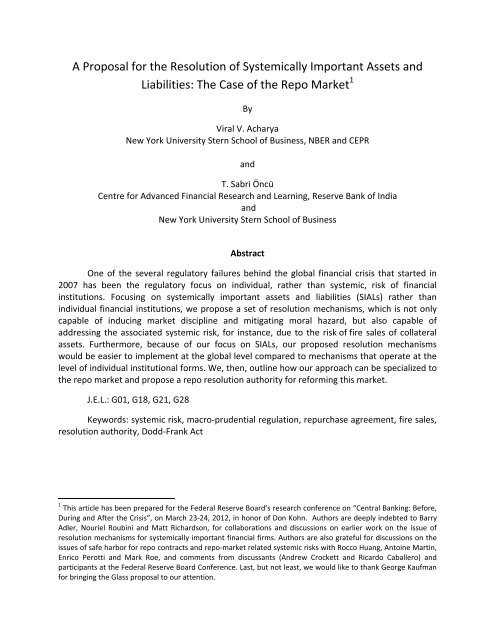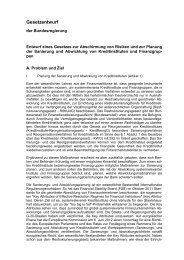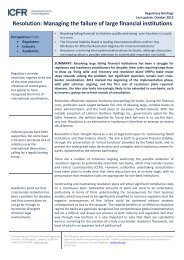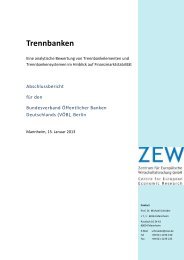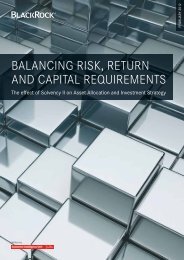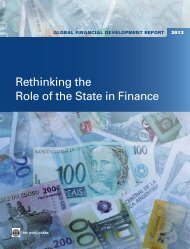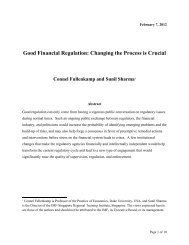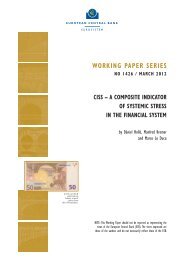A Proposal for the Resolution of Systemically Important Assets and ...
A Proposal for the Resolution of Systemically Important Assets and ...
A Proposal for the Resolution of Systemically Important Assets and ...
You also want an ePaper? Increase the reach of your titles
YUMPU automatically turns print PDFs into web optimized ePapers that Google loves.
A<strong>Proposal</strong><strong>for</strong><strong>the</strong><strong>Resolution</strong><strong>of</strong><strong>Systemically</strong><strong>Important</strong><strong>Assets</strong><strong>and</strong><br />
Liabilities:TheCase<strong>of</strong><strong>the</strong>RepoMarket 1 <br />
By<br />
ViralV.Acharya<br />
NewYorkUniversitySternSchool<strong>of</strong>Business,NBER<strong>and</strong>CEPR<br />
<br />
<strong>and</strong><br />
T.SabriÖncü<br />
Centre<strong>for</strong>AdvancedFinancialResearch<strong>and</strong>Learning,ReserveBank<strong>of</strong>India<br />
<strong>and</strong><br />
NewYorkUniversitySternSchool<strong>of</strong>Business<br />
<br />
Abstract<br />
One <strong>of</strong> <strong>the</strong>severalregulatoryfailuresbehind<strong>the</strong>globalfinancialcrisisthatstartedin<br />
2007 has been <strong>the</strong> regulatory focus on individual, ra<strong>the</strong>r than systemic, risk <strong>of</strong> financial<br />
institutions. Focusing on systemically important assets <strong>and</strong> liabilities (SIALs) ra<strong>the</strong>r than<br />
individualfinancialinstitutions,weproposeaset<strong>of</strong>resolutionmechanisms,whichisnotonly<br />
capable <strong>of</strong> inducing market discipline <strong>and</strong> mitigating moral hazard, but also capable <strong>of</strong><br />
addressing<strong>the</strong>associatedsystemicrisk,<strong>for</strong>instance,dueto<strong>the</strong>risk<strong>of</strong>firesales<strong>of</strong>collateral<br />
assets. Fur<strong>the</strong>rmore, because <strong>of</strong> our focus on SIALs, our proposed resolution mechanisms<br />
wouldbeeasiertoimplementat<strong>the</strong>globallevelcomparedtomechanismsthatoperateat<strong>the</strong><br />
level<strong>of</strong>individualinstitutional<strong>for</strong>ms.We,<strong>the</strong>n,outlinehowourapproachcanbespecializedto<br />
<strong>the</strong>repomarket<strong>and</strong>proposeareporesolutionauthority<strong>for</strong>re<strong>for</strong>mingthismarket.<br />
J.E.L.:G01,G18,G21,G28<br />
Keywords:systemicrisk,macroprudentialregulation,repurchaseagreement,firesales,<br />
resolutionauthority,DoddFrankAct <br />
<br />
1 Thisarticlehasbeenprepared<strong>for</strong><strong>the</strong>FederalReserveBoard’sresearchconferenceon“CentralBanking:Be<strong>for</strong>e,<br />
During<strong>and</strong>After<strong>the</strong>Crisis”,onMarch2324,2012,inhonor<strong>of</strong>DonKohn.AuthorsaredeeplyindebtedtoBarry<br />
Adler, Nouriel Roubini <strong>and</strong> Matt Richardson, <strong>for</strong> collaborations <strong>and</strong> discussions on earlier work on <strong>the</strong> issue <strong>of</strong><br />
resolutionmechanisms<strong>for</strong>systemicallyimportantfinancialfirms.Authorsarealsograteful<strong>for</strong>discussionson<strong>the</strong><br />
issues<strong>of</strong>safeharbor<strong>for</strong>repocontracts<strong>and</strong>repomarketrelatedsystemicriskswithRoccoHuang,AntoineMartin,<br />
Enrico Perotti <strong>and</strong> Mark Roe, <strong>and</strong> comments from discussants (Andrew Crockett <strong>and</strong> Ricardo Caballero) <strong>and</strong><br />
participantsat<strong>the</strong>FederalReserveBoardConference.Last,butnotleast,wewouldliketothankGeorgeKaufman<br />
<strong>for</strong>bringing<strong>the</strong>Glassproposaltoourattention.
I.Introduction<br />
Systemicriskcanbedefinedbroadlyas<strong>the</strong>expectedlossesfrom<strong>the</strong>riskthat<strong>the</strong>failure<br />
<strong>of</strong> a significant part <strong>of</strong> <strong>the</strong> financial sector leads to a reduction in credit availability with <strong>the</strong><br />
potential<strong>for</strong>adverselyaffecting<strong>the</strong>realeconomy. 2 Thereareatleasttwocontestingviewson<br />
<strong>the</strong>causes<strong>of</strong>systemicrisk.In<strong>the</strong>socalledmicroprudentialview,<strong>the</strong>systemicriskarisesfrom<br />
contagion<strong>of</strong><strong>the</strong>failure<strong>of</strong>afinancialinstitutionto<strong>the</strong>rest<strong>of</strong><strong>the</strong>financialsector.Asshort<br />
termcreditors<strong>of</strong>aninstitutiondem<strong>and</strong>immediacyagainstitslongtermassets(“run”),short<br />
termcreditors<strong>of</strong>interconnectedorsimilarinstitutionsmaydem<strong>and</strong>suchimmediacytoo.In<br />
contrast, in <strong>the</strong> socalled macroprudential view, <strong>the</strong> systemic risk arises from <strong>the</strong> collective<br />
failure <strong>of</strong> many financial institutions because <strong>of</strong> <strong>the</strong>ir common risk factor exposures. In this<br />
view,whenshorttermcreditors<strong>of</strong>aninstitutiondem<strong>and</strong>immediacyagainstlongtermassets,<br />
<strong>the</strong>reisadisruptiverunonlyifo<strong>the</strong>rinstitutionsareunabletoacquire<strong>the</strong>longtermassetsat<br />
fairvalues;inparticular,ifinstitutionshavecorrelatedexposures,<strong>the</strong>no<strong>the</strong>rinstitutionsare<br />
potentially facing runs too <strong>and</strong> assets must be sold at firesale prices, resulting in disorderly<br />
liquidations,potentialallocationinefficiencies<strong>and</strong>ageneralincreasein<strong>the</strong>rate<strong>of</strong>returnon<br />
savings(whichcaninducehoardingbehavior<strong>and</strong>cutbackonrealsectorlending).<br />
<br />
Although<strong>the</strong>setwoviewsarenotmutuallyexclusive,much<strong>of</strong><strong>the</strong>regulatoryre<strong>for</strong>ms<br />
takeoneviewor<strong>the</strong>o<strong>the</strong>r.In<strong>the</strong>microprudentialregulations,<strong>the</strong>focusison<strong>the</strong>systemically<br />
importantfinancialinstitutions(SIFIs)whereasin<strong>the</strong>macroprudentialregulations,<strong>the</strong>focusis<br />
(also) on <strong>the</strong> risk <strong>of</strong> a crisis in <strong>the</strong> financial sector <strong>and</strong> its spillover to <strong>the</strong> economy at large.<br />
Taking<strong>the</strong>microprudentialview,both<strong>the</strong>DoddFrankWallStreetRegulation<strong>and</strong>Consumer<br />
Protection Act (DFA) signed into law by President Obama in July 2010 in <strong>the</strong> U.S. <strong>and</strong>,<br />
internationally,BaselIIIfocusonsinglefinancialinstitutions.<br />
<br />
SIFIs consist <strong>of</strong> financial intermediaries that are not only commercial banks taking<br />
deposits <strong>and</strong> making loans, but also include investment banks, money market funds, mutual<br />
funds,insurancefirms<strong>and</strong>potentiallyevenhedgefunds,whosefailureposesasystemicriskto<br />
<strong>the</strong> financial system. This systemic risk can come through multiple <strong>for</strong>ms which include<br />
counterparty risk on o<strong>the</strong>r financial institutions, asset liquidations that can produce a<br />
depressing effect on asset prices, liquidity hoarding that raises funding costs in interbank<br />
markets even <strong>for</strong> safe firms, <strong>and</strong> an in<strong>for</strong>mation contagion effect resulting in a significant<br />
reductioninoverallmarketliquidity.There<strong>for</strong>e,anymechanismsetupby<strong>the</strong>regulatorstodeal<br />
with <strong>the</strong> insolvency <strong>of</strong> SIFIs must follow at least four basic principles (Acharya, Adler,<br />
Richardson<strong>and</strong>Roubini,2010):<br />
<br />
1) Thecounterpartyrisk<strong>of</strong><strong>the</strong>SIFIsmustbecontainedthroughregulationsincluding<br />
<strong>the</strong> imposition <strong>of</strong> capital requirements, margin rules, <strong>and</strong> limitation on risky<br />
investmentsexante.<br />
<br />
<br />
2 ThisdefinitionisbasedonAcharya,Pedersen,Philippon<strong>and</strong>Richardson(2010).See,<strong>for</strong>example,Kaufman<strong>and</strong><br />
Scott(2003)<strong>for</strong>o<strong>the</strong>rdefinitions.<br />
<br />
2
2) There needs to be a procedure <strong>for</strong> dealing with large amounts <strong>of</strong> illiquid assets<br />
whose<strong>for</strong>cedsalescanhaveacatastrophiceffecton<strong>the</strong>financialsystem.<br />
<br />
3) Theresolutionmechanismshouldbeabletoidentifyinsolventinstitutionspromptly<br />
as <strong>the</strong>y can become pockets where financial resources <strong>of</strong> <strong>the</strong> economy can get<br />
trapped,potentiallycreatingfundingproblemseven<strong>for</strong>o<strong>the</strong>rwisesolventfirms.<br />
<br />
4) Theremustbewelldefinedrules<strong>for</strong>whathappensto<strong>the</strong>liabilities<strong>of</strong><strong>the</strong>financial<br />
institutionwhenitfails,<strong>for</strong>o<strong>the</strong>rwisearunonmost<strong>of</strong><strong>the</strong>institution’sliabilitieswill<br />
occur,potentiallyleadingtoasystemwiderun.<br />
<br />
Fur<strong>the</strong>rmore,sincemanySIFIsoperateacrossborders(globalSIFIs–GSIFIs)<strong>and</strong>,aswehave<br />
witnessed in <strong>the</strong> recent financial crisis, <strong>the</strong>ir failure can threaten <strong>the</strong> integrity <strong>of</strong> <strong>the</strong> entire<br />
globalfinancialsystem,to<strong>the</strong>abovefourprincipleswemustadd:<br />
<br />
5) The national resolution mechanisms should be amenable to easy international<br />
coordination<strong>for</strong><strong>the</strong>effectiveresolution<strong>of</strong>GSIFIs.<br />
<br />
When <strong>the</strong> collapse or near collapse <strong>of</strong> such financial institutions as Bear Stearns,<br />
LehmanBro<strong>the</strong>rs,AIG<strong>and</strong><strong>the</strong>likeafter<strong>the</strong>onset<strong>of</strong><strong>the</strong>globalfinancialcrisisin2007made<strong>the</strong><br />
inability<strong>of</strong><strong>the</strong>existingresolutionmechanismstodealwith<strong>the</strong>failure<strong>of</strong>SIFIsclear,<strong>the</strong>U.S.<br />
was<strong>the</strong>firstmoverwith<strong>the</strong>DoddFrankAct.Toaddress<strong>the</strong>concernsabout<strong>the</strong>inability<strong>of</strong><strong>the</strong><br />
existing resolution mechanisms to h<strong>and</strong>le <strong>the</strong> failure <strong>of</strong> SIFIs, Title II <strong>of</strong> <strong>the</strong> DFA created <strong>the</strong><br />
OrderlyLiquidationAuthority(OLA)asanewmechanism.However,asitisstatedfairlyclearly<br />
inTitleII<strong>of</strong><strong>the</strong>DFA,<strong>the</strong>OLAisnotaresolutionbutliquidationmechanism. 3 <br />
<br />
Putting aside <strong>the</strong> question <strong>of</strong> whe<strong>the</strong>r such liquidation – ra<strong>the</strong>r than a resolution –<br />
authority focusing on individual financial institutions is sufficient to achieve <strong>the</strong> DFAstated<br />
goals<strong>of</strong>inducingmarketdiscipline<strong>and</strong>mitigatingmoralhazard,<strong>the</strong>question<strong>of</strong>whe<strong>the</strong>r<strong>the</strong><br />
OLAcanaddress<strong>the</strong>systemicriskassociatedwithsuchsystemicallyimportantmarketsas<strong>the</strong><br />
sale<strong>and</strong>repurchaseagreement(“repo”)marketorsuchsystemicallyimportantsectors<strong>of</strong>small<br />
institutionsas<strong>the</strong>moneymarketmutualfundsremainsdebatable. 4 Althoughwediscussour<br />
concerns regarding <strong>the</strong> OLA in <strong>the</strong> next section in detail, let us give a simple example from<br />
September,2008,toillustratehow<strong>the</strong>OLAmayfailincontaining<strong>the</strong>systemicrisk:<br />
<br />
After <strong>the</strong> Lehman Bro<strong>the</strong>rs’ bankruptcy filed on September 15, 2008, its outst<strong>and</strong>ing<br />
debt collapsed in price almost immediately. Since one <strong>of</strong> <strong>the</strong> largest money market mutual<br />
funds(MMMFs),<strong>the</strong>ReservePrimaryFund,washighlyexposedtoLehmanBro<strong>the</strong>rs'collapsing<br />
shortterm debt, <strong>the</strong> next day its net asset value (NAV) fell below par. Since MMMFs <strong>of</strong>fer<br />
stableNAV<strong>and</strong>investorscanredeemanytimeatpar,animmediaterunon<strong>the</strong>ReservePrimary<br />
<br />
3<br />
HR4173,TitleII,“OrderlyLiquidationAuthority,”Sec.204,“OrderlyLiquidation<strong>of</strong>CoveredFinancialCompanies.”<br />
4<br />
See,Acharya,Adler,Richardson,<strong>and</strong>Roubini(2010)<strong>and</strong>Acharya,Cooley,Richardson,<strong>and</strong>Walter(2011)<strong>for</strong><br />
detaileddiscussions.<br />
3
Fund occurred, causing it to shut down. This failure opened up <strong>the</strong> possibility that o<strong>the</strong>r<br />
MMMFsweresimilarlyexposed<strong>and</strong>arunon<strong>the</strong>MMMFsstarted.SinceMMMFsareaprimary<br />
source<strong>for</strong><strong>the</strong>commercialpapermarket,thisrunopenedup<strong>the</strong>possibility<strong>of</strong>capitalshortfalls<br />
at many financial institutions that needed to roll over commercial paper. Only after <strong>the</strong><br />
governmentguaranteed<strong>the</strong>MMMFdeposits100%<strong>the</strong>runcametoahalt<strong>and</strong><strong>the</strong>slidewas<br />
stopped.<br />
<br />
Under<strong>the</strong>OLA,ifinvokedasdescribedinTitleII<strong>of</strong><strong>the</strong>DFA,<strong>the</strong>ReservePrimaryFund<br />
would have been placed into a receivership administered by <strong>the</strong> Federal Deposit Insurance<br />
Corporation(FDIC)tobeliquidated(assumingthat<strong>the</strong>ReservePrimaryFund–or<strong>the</strong>money<br />
marketfundssectorasawhole–weredeemedsystemicallyimportantby<strong>the</strong>FinancialStability<br />
Oversight Council, set up under <strong>the</strong> DFA). Although <strong>the</strong> FDIC could have borrowed from <strong>the</strong><br />
Treasuryt<strong>of</strong>inance<strong>the</strong>liquidation,if<strong>the</strong>proceedsfromliquidationwereinsufficienttorepay<br />
<strong>the</strong>Treasury,<strong>the</strong>FDICwouldhavehadtoclawbackfromcreditorsanyamountsreceivedin<br />
excess<strong>of</strong>what<strong>the</strong>ywouldhavereceivedinanordinaryliquidation. 5 Giventhat<strong>the</strong>investors<strong>of</strong><br />
MMMFswere<strong>of</strong>feredstableNAV<strong>and</strong>promisedthat<strong>the</strong>ycouldredeemanytimeatpar,itis<br />
evidentthataliquidationauthoritysuchas<strong>the</strong>OLA–whichwithitsfocusoneliminating<strong>the</strong><br />
moralhazardassociatedwith<strong>the</strong>“toobigt<strong>of</strong>ail”statusrecoversfromcreditorsanyamounts<br />
receivedinexcess<strong>of</strong>what<strong>the</strong>ywouldhavereceivedinanordinaryliquidation–nei<strong>the</strong>rcould<br />
havenorwillhavestopped<strong>the</strong>slideinsuchanepisode. 6 Anorderlyliquidation<strong>of</strong><strong>the</strong>assets<strong>of</strong><br />
<strong>the</strong>ReservePrimaryFundwasnotevenanissue<strong>the</strong>n.Fur<strong>the</strong>rmore,nei<strong>the</strong>rwas<strong>the</strong>Reserve<br />
PrimaryFund“toobigt<strong>of</strong>ail”despiteits$64.8billionworth<strong>of</strong>assetspriortoitsshutdown,<br />
norwasitevenanSIFIonitsownright.WhatwassystemicallyimportantinSeptember,2008,<br />
was<strong>the</strong>$3.5trillionfinancialsector<strong>of</strong>MMMFs.Theinterventionhadtobedoneat<strong>the</strong>sector<br />
leveltoavoidapossiblecollapse<strong>of</strong><strong>the</strong>entirefinancialsystem.<br />
<br />
Ano<strong>the</strong>r problem associated with <strong>the</strong> OLA is that it does not apply to <strong>the</strong> <strong>for</strong>eign<br />
subsidiaries<strong>of</strong><strong>the</strong>GSIFIs.Forexample,whenLehmanBro<strong>the</strong>rsfiled<strong>for</strong>Chapter11protection<br />
inSeptember,2008,thisactiontriggeredwellover60insolvencyproceedingsworldwidesome<br />
<strong>of</strong>whichwereparticularlyharmfultoglobalfinancialstability(Acharya,Adler<strong>and</strong>Richardson,<br />
2011).Evenif<strong>the</strong>OLAexistedat<strong>the</strong>time<strong>of</strong><strong>the</strong>LehmanBro<strong>the</strong>rs’insolvency,<strong>the</strong>assets<strong>and</strong><br />
liabilities<strong>of</strong>itsU.K.primebrokeragewouldhavebeenresolvedunder<strong>the</strong>U.K.law.Althoughin<br />
response to <strong>the</strong> G20 call <strong>for</strong> action, <strong>the</strong> Financial StabilityBoard (FSB) issued recently a new<br />
internationalst<strong>and</strong>ard<strong>for</strong>resolutionmechanisms“sothatanyfinancialinstitution,whateverits<br />
size <strong>and</strong> complexity, can be resolved without disruption to <strong>the</strong> financial system <strong>and</strong> without<br />
taxpayersolvencysupport” 7 ,itisstillunclearhowthisnewst<strong>and</strong>ardwillbeimplementedin<strong>the</strong><br />
U.S.<strong>and</strong>canbereconciledwith<strong>the</strong>OLA.<br />
<br />
<br />
5 If<strong>the</strong>reisanyremainingshortfall,<strong>the</strong>FDICcanlevyanassessmentonallfinancialcompaniesdeemedanSIFIby<br />
<strong>the</strong>involvedregulators.<br />
6 Had<strong>the</strong>MMMFs<strong>of</strong>feredfloatingra<strong>the</strong>rthanstableNAV,<strong>the</strong>remightnothavebeenarunon<strong>the</strong>Reserve<br />
PrimaryFund,entailing<strong>the</strong>systemwiderunonallMMMFs,<strong>of</strong>course.However,insuchascenario,allMMMFs<br />
wouldbedisintermediatedby<strong>the</strong>bankmoneymarketaccountsrapidly.<br />
7 www.financialstabilityboard.org/press/pr_111104dd.pdf<br />
<br />
4
Fur<strong>the</strong>rmore, even <strong>the</strong> FSB issued new international st<strong>and</strong>ard described in its<br />
November, 2011, “Key Attributes” document 8 focuses on individual financial institutions that<br />
aretobedeemedgloballysystemicallyimportant,thatis,GSIFI.Toseewhythismightbea<br />
problem,take,<strong>for</strong>example,<strong>the</strong>rehypo<strong>the</strong>cation<strong>of</strong>hedgefunds’assetsheldatLehman’sU.K.<br />
prime brokerage unit during Lehman’s bankruptcy. Under <strong>the</strong> U.K. law (which was changed<br />
later),<strong>the</strong>seassetsbecameLehman’screditorstake.Thislednotonlytorunsonhedgefunds,<br />
butalsotooveralluncertaintyaboutwhichassetsatfinancialinstitutionsweresafe<strong>and</strong>which<br />
werenot(Acharya,Adler<strong>and</strong>Richardson,2011).NoresolutionmechanismfocusingonGSIFIs,<br />
evenifinternationallycoordinatedasdescribedin“KeyAttributes”,couldhaveworkedquickly<br />
enoughtostop<strong>the</strong>seeffects.<br />
<br />
Finally,while<strong>the</strong>rewereindeedrunsonSIFIsinthis<strong>and</strong>previouscrises,<strong>the</strong>rewerealso<br />
alargenumber<strong>of</strong>collectiverunsonrelativelysmallerfinancialinstitutions,especiallyin<strong>the</strong>so<br />
called“shadowbanking”,suchasonhedgefunds,specialpurposevehicles(conduits<strong>and</strong>SIVs),<br />
<strong>and</strong> as discussed earlier, moneymarket funds. For instance, <strong>the</strong> assetbacked commercial<br />
paper(ABCP)runonconduits<strong>and</strong>SIVssponsoredbycommercialbanksstarting8 th <strong>of</strong>August<br />
2007(seeAcharya,Schnabl<strong>and</strong>Suarez,2009)highlightsthatcollection<strong>of</strong>smallinstitutions<strong>and</strong><br />
anentireclass<strong>of</strong>claimsormarketscanalso besystemicallyimportant,i.e.,<strong>the</strong>ir failurecan<br />
leadtosystemwideloss<strong>of</strong>financialintermediation.<br />
<br />
With<strong>the</strong>seinmind<strong>and</strong>taking<strong>the</strong>macroprudentialview,weproposeanalternativeset<br />
<strong>of</strong> resolution mechanisms, based on <strong>the</strong> insights <strong>of</strong> Acharya, Adler <strong>and</strong> Richardson (2011),<br />
whichisnotat<strong>the</strong>level<strong>of</strong>SIFIs,butat<strong>the</strong>level<strong>of</strong>systemicallyimportantassets<strong>and</strong>liabilities<br />
(SIALs)<strong>of</strong>financialinstitutions,whe<strong>the</strong>r<strong>the</strong>seinstitutionsaredeemedsystemicallyimportant<br />
or not. <strong>Systemically</strong> important liabilities (SILs) can be defined broadly as those liabilities <strong>of</strong><br />
highlyleveragedentitiesthatareassets<strong>of</strong>o<strong>the</strong>rhighlyleveragedentities<strong>and</strong><strong>the</strong>re<strong>for</strong>ewhen<br />
faced with haircuts in case <strong>of</strong> default would trigger runs on o<strong>the</strong>r entities. Examples <strong>of</strong> SILs<br />
include deposits, repos <strong>and</strong> over<strong>the</strong>counter (OTC) derivatives. Similarly, systemically<br />
important assets (SIAs) can be defined broadly as those assets that are ei<strong>the</strong>r SILs <strong>of</strong> o<strong>the</strong>r<br />
highlyleveragedentitiesorpotentiallyilliquid,highriskassetsfinancedthroughSILs.Examples<br />
<strong>of</strong> SIAs include exposures to SIFIs, assetbacked commercial paper (ABCP) <strong>and</strong> risky repo<br />
collaterals such as mortgagebacked securities (MBSs). To <strong>the</strong> extent possible, <strong>the</strong> set <strong>of</strong><br />
mechanismsshouldbeexp<strong>and</strong>edtocoverasmanyclasses<strong>of</strong>systemicallyimportantassets<strong>and</strong><br />
liabilitiesaspossible. 9 <br />
<br />
What we propose is that instead <strong>of</strong> attempting regulation <strong>of</strong> systemically important<br />
financialinstitutions(a“topdown”approachtoregulatingsystemicallyimportantassets<strong>and</strong><br />
liabilities), prudential regulation be built in <strong>the</strong> <strong>for</strong>m <strong>of</strong> a “bottom up” approach – one that<br />
worksat<strong>the</strong>level<strong>of</strong><strong>the</strong>SIALsra<strong>the</strong>rthanat<strong>the</strong>level<strong>of</strong><strong>the</strong>SIFIthatowns<strong>the</strong>m.Under<strong>the</strong><br />
<br />
8 www.financialstabilityboard.org/publications/r_111104bb.pdf<br />
9 Adetaileddiscussion<strong>of</strong>ourapproach,originallyproposedbyAcharya,Adler<strong>and</strong>Richardson(2011),canbefound<br />
in<strong>the</strong>irdocumentwhereasadetailedanalysis<strong>of</strong>manyreasonsthatwarrantmacroprudentialregulationsra<strong>the</strong>r<br />
thanmicroprudentialregulationscanbefoundinAcharya(2011).<br />
<br />
5
“bottomup” approach <strong>the</strong>re would be an automatic stabilizer built <strong>for</strong> each SIAL. The<br />
automaticstabilizerscouldbein<strong>the</strong><strong>for</strong>m<strong>of</strong>governmentprovidedbutappropriatelycharged<br />
depositinsurance,centrallyclearedSIALswithinitial<strong>and</strong>variationmarginsorhaircutscharged<br />
by a clearinghouse or dedicated resolution authority <strong>for</strong> those SIALs, <strong>and</strong> in extreme cases,<br />
lender<strong>of</strong>lastresortfrom<strong>the</strong>centralbankagainsteligibleassets(buttoavoidmoralhazard,<br />
only to firms that pay a marketrate fee). This way, when an SIFI fails, it is not <strong>the</strong> orderly<br />
resolution<strong>of</strong>anindividualSIFIthathastobeeffected,butra<strong>the</strong>r<strong>the</strong>resolution<strong>of</strong>itsvarious<br />
SIALs;<strong>the</strong>parts<strong>of</strong>itscapitalstructurethatarenotsystemicallyimportantwouldberesolvedby<br />
marketdetermined contracts <strong>and</strong> relevant bankruptcy procedures. A particularly attractive<br />
feature<strong>of</strong><strong>the</strong>“bottomup”approachisthatitrequiresnouni<strong>for</strong>minstitutionlevelinsolvency<br />
process <strong>and</strong> <strong>the</strong>re<strong>for</strong>e might be <strong>the</strong> simplest way <strong>of</strong> achieving international agreement on<br />
resolving <strong>the</strong> financial distress <strong>of</strong> GSIFIs (as long as <strong>the</strong>re is global agreement on resolution<br />
mechanisms<strong>for</strong>SIALs).<br />
<br />
Wepresentasaleadingexample<strong>of</strong>ourapproach<strong>the</strong>systemicallyimportantassets<strong>and</strong><br />
liabilities underlying <strong>the</strong> repo market <strong>and</strong> propose a potential repo resolution authority <strong>for</strong><br />
re<strong>for</strong>ming <strong>the</strong> repo market to illustrate how our approach can be implemented <strong>for</strong> this<br />
particular class <strong>of</strong> SIALs. 10 A repurchase agreement – also known as a “sale <strong>and</strong> repurchase<br />
agreement,”ormorepopularlyasarepo–isashorttermtransactionbetweentwopartiesin<br />
whichonepartyborrowscashfrom<strong>the</strong>o<strong>the</strong>rbypledgingafinancialsecurityascollateral.One<br />
importantfeature<strong>of</strong><strong>the</strong>U.S.repomarketisthatalltransactionsthatfallunder<strong>the</strong>umbrella<strong>of</strong><br />
reposareexemptfrom<strong>the</strong>automaticstayinbankruptcy<strong>and</strong><strong>the</strong>re<strong>for</strong>eallrepotransactions<br />
canbeliquidatedfollowingabankruptcyfiling.Asiswellknown,<strong>the</strong>ongoingglobalfinancial<br />
crisiswastriggeredin<strong>the</strong>summer<strong>of</strong>2007essentiallybya“run”ontwoBearStearnshedge<br />
fundsspeculatingin<strong>the</strong>potentiallyilliquidsubprimemortgagesbyborrowingshorttermin<strong>the</strong><br />
U.S.repomarket<strong>and</strong>eventuallyonBearStearnsinMarch<strong>of</strong>2008.Wedescribe<strong>the</strong>se“repo<br />
bankruns”<strong>and</strong><strong>the</strong>role<strong>the</strong>firesaleliquidation<strong>of</strong><strong>the</strong>repocollaterals–thatareexemptfrom<br />
<strong>the</strong>automaticstay–playedin<strong>the</strong>ensuingsystemiccrisis(inSectionIII.2indetail).<br />
<br />
Ourproposal<strong>for</strong>resolvingreporunsistocreatea“Repo<strong>Resolution</strong>Authority”ineach<br />
jurisdiction with significant repo transactions. The repo collaterals will in general not be<br />
exemptfrombankruptcy<strong>of</strong>borrowingfinancialfirms,exceptwhen<strong>the</strong>collateralisin<strong>the</strong><strong>for</strong>m<br />
<strong>of</strong>highestqualitygovernmentorgovernmentguaranteedbonds.Allo<strong>the</strong>rrepocollateralon<br />
defaultingrepotransactionswillberesolvedby<strong>the</strong>reporesolutionauthority,whichmakesan<br />
immediate “liquidity” payment to repo financiers. The immediate payment is based on<br />
conservativeassumptions(a“haircut”)about<strong>the</strong>liquidationproceedsfrom<strong>the</strong>collateral.The<br />
realizedproceedswillingeneralexceedorbesmallerthan<strong>the</strong>conservativepayment<strong>and</strong>will<br />
be repatriated or clawedback from repo financiers. In <strong>the</strong> process, however, <strong>the</strong> repo<br />
resolutionauthoritytakesoncreditrisk<strong>of</strong><strong>the</strong>rep<strong>of</strong>inanciers.Tomanagethiscreditrisk<strong>and</strong>to<br />
attenuate<strong>the</strong>moralhazardinducedonpart<strong>of</strong>rep<strong>of</strong>inanciers,<strong>the</strong>reporesolutionauthority<br />
wouldincludeaseligibleonlyrelativelyhighqualitycollateral;chargerep<strong>of</strong>inanciersanexante<br />
<br />
10 The proposal <strong>and</strong> discussion to follow elaborate on <strong>the</strong> initial case <strong>the</strong> authors made in Acharya <strong>and</strong> Öncü<br />
(2010).<br />
<br />
6
fee<strong>for</strong><strong>the</strong>liquidityenhancementprovidedincase<strong>of</strong>defaultinamannerthatiscommensurate<br />
with<strong>the</strong>residualcreditriskborneby<strong>the</strong>facility;requirethateligiblerep<strong>of</strong>inanciersmeetpre<br />
specified solvency criteria; <strong>and</strong> impose a concentration limit at <strong>the</strong> level <strong>of</strong> individual repo<br />
financiers,aswellason<strong>the</strong>financier’soverallportfoliosize.<br />
<br />
In effect, <strong>the</strong> repo resolution authority does resemble a clearinghouse <strong>for</strong> repo<br />
contracts, in that it has <strong>the</strong> right to suspend automatic conversion <strong>of</strong> repo claims into<br />
liquidations<strong>of</strong>underlyingcollateral,ittakeson<strong>the</strong>liquidationrightsitselfbutensuresthatits<br />
provision<strong>of</strong>liquidityto<strong>the</strong>marketincase<strong>of</strong>defaultdoesnotengenderinsolvencyconcerns.<br />
Therep<strong>of</strong>inanciers,whichfaceparticipationcriteria<strong>and</strong>haircutsingoodtimes,wouldpasson<br />
<strong>the</strong>relevantcoststoborrowersin<strong>the</strong>repomarkets.Collateralthatisnoteligible<strong>for</strong><strong>the</strong>repo<br />
resolutionauthoritywouldremainoutside<strong>of</strong>bankruptcyexemptionaswellasoutside<strong>of</strong><strong>the</strong><br />
liquidityenhancementprovidedby<strong>the</strong>reporesolutionauthority;<strong>the</strong>secontractswouldthus<br />
berelativelysubordinatedin<strong>the</strong>capitalstructure<strong>of</strong>financialfirms<strong>and</strong><strong>the</strong>ycouldbesubjectto<br />
prudential capital requirements or minimum haircut/overcollateralization requirements (as<br />
witho<strong>the</strong>rparts<strong>of</strong><strong>the</strong>capitalstructure<strong>of</strong>financialfirms).<br />
<br />
An important issue that our proposed resolution approach highlights is that <strong>of</strong> <strong>the</strong><br />
desirability <strong>of</strong> granting unconditional liquidation rights (“safe harbor” provisions) to certain<br />
claims<strong>of</strong>creditors(“qualifiedfinancialcontracts”)<strong>of</strong>financialinstitutions.Theadvantage<strong>of</strong><br />
grantingsuchrightsistoextendmoneylikeimmediacypropertiestosuchclaims<strong>and</strong>enhance<br />
<strong>the</strong> capacity <strong>of</strong> financial institutions to generate liquidity. The macroprudential view <strong>of</strong><br />
financialcriseshighlights,however,thatintimes<strong>of</strong>asubstantialaggregateshock,<strong>the</strong>system<br />
mayberenderedincapable<strong>of</strong>grantingsuchimmediacytoallcreditors<strong>of</strong>financialinstitutions:<br />
not all dem<strong>and</strong>able deposits can be paid <strong>of</strong>f without resorting to bank failures <strong>and</strong> loss <strong>of</strong><br />
relationshiploans,ornotallrepoorderivativecounterpartiescanbepaid<strong>of</strong>fwithoutengaging<br />
indisorderlyfiresales<strong>and</strong>generatingassociatedexternalities.<br />
<br />
Indeed,inmuch<strong>the</strong>samewaythatcommercialbankclearinghousesin<strong>the</strong>preFederal<br />
Reserveerawere<strong>for</strong>cedtosuspendconversion<strong>of</strong>immediacy<strong>of</strong>dem<strong>and</strong>abledepositsinorder<br />
to stem bank runs, our proposal recommends that safe harbor provisions be conditionally<br />
suspended when <strong>the</strong>re has been a sufficiently adverse common shock to <strong>the</strong> financial<br />
institutions.Whensuchsystemicexceptionisinvokedonsafeharborprovisions,ourresolution<br />
approach grants partial immediacy to <strong>the</strong> affected claims (through <strong>the</strong> repo resolution<br />
authorityor<strong>the</strong>lender<strong>of</strong>lastresort),butsuspendsimmediacy<strong>of</strong><strong>the</strong>remainingpart<strong>for</strong>cing<br />
<strong>the</strong>mtobearlongrunrisk<strong>of</strong><strong>the</strong>underlyingcollateralorassetsbacking<strong>the</strong>claims.Thelong<br />
run risk is managed in an orderly manner by such suspension, making it clear that <strong>the</strong><br />
clearinghouses,reporesolutionauthorities<strong>and</strong><strong>the</strong>lender<strong>of</strong>lastresortmustalsobegranted<br />
assetliquidationrightsintimes<strong>of</strong>systemiccrises.Equallyimportantly,sincemanagement<strong>of</strong><br />
such risk exposes <strong>the</strong>se authorities to potential losses, <strong>the</strong>y are also granted <strong>the</strong> rights to<br />
containapriori<strong>the</strong>extent<strong>of</strong>immediacygrantedbyfinancialfirmsto<strong>the</strong>ircreditors.<br />
<br />
Weorganize<strong>the</strong>rest<strong>of</strong><strong>the</strong>paperasfollows:InSectionII,wedescribesomespecific<br />
details<strong>of</strong><strong>the</strong>DFA,<strong>and</strong>evaluateitwithrespectto<strong>the</strong>efficiency<strong>of</strong><strong>the</strong>process<strong>and</strong>itsabilityto<br />
<br />
7
mitigatemoralhazard<strong>and</strong>systemicrisk.InSectionIII,wedescribehow<strong>the</strong>repomarketcame<br />
toplaysuchanimportantroleinsecuritizedbankingin<strong>the</strong>U.S.,discussitscriticalrolein<strong>the</strong><br />
<strong>for</strong>m<strong>of</strong>runsin<strong>the</strong>crisis,<strong>and</strong>argueacase<strong>for</strong>re<strong>for</strong>ming<strong>the</strong>repomarketbasedonouranalysis.<br />
We<strong>the</strong>noutlineinSectionIVourproposed“Repo<strong>Resolution</strong>Authority”<strong>for</strong>suchre<strong>for</strong>m,<strong>and</strong><br />
compare <strong>and</strong> contrast it with an interesting precedent, <strong>the</strong> Federal Government Liquidation<br />
CorporationproposedbySenatorGlassin<strong>the</strong>early1930s,inSectionV.Finally,inSectionVI,we<br />
discuss how our proposed resolution mechanism <strong>for</strong> <strong>the</strong> repo market may be coordinated<br />
globally<strong>and</strong>presentourconcludingremarks.<br />
<br />
II.TheDoddFrank<strong>Resolution</strong>Mechanism<strong>for</strong>NonbankSIFIs<br />
A central objective <strong>of</strong> <strong>the</strong> DFA is to create a new resolution mechanism <strong>for</strong> nonbank<br />
SIFIs <strong>and</strong> bring <strong>the</strong>m within <strong>the</strong> FDIC insurance model. Established in 1933, <strong>the</strong> FDIC is an<br />
independentfederalagency<strong>of</strong><strong>the</strong>U.S.thatinsuresdepositsatitsmemberbanks<strong>and</strong>savings<br />
<strong>and</strong> loan institutions, currently up to $250,000 per depositor per institution. If a member<br />
institution fails, it is taken into receivership by <strong>the</strong> FDIC, which within a few days ei<strong>the</strong>r<br />
facilitatesamergerwithano<strong>the</strong>rFDICinsuredinstitutionorpayseachdepositor<strong>for</strong><strong>the</strong>insured<br />
portion<strong>of</strong><strong>the</strong>iraccountsat<strong>the</strong>closedinstitution<strong>and</strong><strong>the</strong>nliquidates<strong>the</strong>closedinstitution’s<br />
assets.Since<strong>the</strong>FederalDepositInsuranceRe<strong>for</strong>mAct<strong>of</strong>2005signedintolawbyPresident<br />
BushinFebruary2006<strong>and</strong>becameeffectiveMarch31,2006,<strong>the</strong>FDICfinances<strong>the</strong>liquidations<br />
from<strong>the</strong>DepositInsuranceFund(DFI)towhichmemberinstitutionspayanexanteinsurance<br />
feebasedon<strong>the</strong>balance<strong>of</strong>insureddeposits,aswellason<strong>the</strong>FDICassessedrisk<strong>the</strong>institution<br />
posesto<strong>the</strong>DFI. 11 And,iffur<strong>the</strong>rfundsareneeded,<strong>the</strong>FDICc<strong>and</strong>rawonaline<strong>of</strong>creditwith<br />
<strong>the</strong>U.S.Treasury.Fur<strong>the</strong>rmore,<strong>the</strong>FDICdepositinsuranceisbackedby<strong>the</strong>fullfaith<strong>and</strong>credit<br />
<strong>of</strong><strong>the</strong>U.S.government,whichmeansthat<strong>the</strong>resources<strong>of</strong><strong>the</strong>U.S.governmentst<strong>and</strong>behind<br />
FDICinsureddepositors.<br />
<br />
AccordingtoSheilaBair(FDIC,2011),<strong>the</strong><strong>for</strong>merchair<strong>of</strong><strong>the</strong>FDIC,<strong>the</strong>DFAresolution<br />
mechanismhas<strong>the</strong>sebasicelements:<br />
<br />
1) TitleI:Theestablishment<strong>of</strong><strong>the</strong>FinancialStabilityOversightCouncil(FSOC),chaired<br />
by<strong>the</strong>Secretary<strong>of</strong><strong>the</strong>Treasury<strong>and</strong>comprised<strong>of</strong>membersfrom<strong>the</strong>o<strong>the</strong>rfinancial<br />
regulatory agencies, with <strong>the</strong> responsibility <strong>of</strong> designating SIFIs or “covered<br />
companies" that will be subject to heightened supervision by <strong>the</strong> Federal Reserve<br />
Board<strong>of</strong>Governors(FRB);<br />
<br />
2) Title I: The requirement <strong>for</strong> <strong>the</strong> preparation <strong>of</strong> detailed resolution plans – <strong>of</strong>ten<br />
referredtoas“livingwills"–bycoveredcompaniestodemonstratethat<strong>the</strong>yare<br />
resolvable under <strong>the</strong> bankruptcy laws if <strong>the</strong>y run into severe financial stress <strong>and</strong><br />
providevaluableadvancein<strong>for</strong>mationthatwillassistinimplementing<strong>the</strong>irorderly<br />
liquidation,ifnecessary;<br />
<br />
<br />
11 Forahistorypriorto2006,see:http://www.fdic.gov/deposit/insurance/history.html<br />
<br />
8
3) Title II: The prohibition <strong>of</strong> bailouts <strong>of</strong> individual companies by providing an<br />
alternativetobankruptcywith<strong>the</strong>establishment<strong>of</strong>anOLA,whichallows<strong>the</strong>FDIC<br />
toresolvenonbankfinancialcompaniesbyusingmany<strong>of</strong><strong>the</strong>sametrusteepowers<br />
oversystemicnonbankfinancialcompaniesthatithaslongusedtomanagefailed<br />
bankreceiverships.<br />
<br />
TheDFAcharacterizesnonbankfinancialcompaniesthatcanbecoveredunder<strong>the</strong>OLA<br />
quitebroadly.Thecompanieseligible<strong>for</strong>coveredfinancialcompany(CFC)designationinclude<br />
bank holding companies, nonbank financial companies supervised by <strong>the</strong> FRB <strong>and</strong> any o<strong>the</strong>r<br />
companypredominantlyengagedinactivitiesthat<strong>the</strong>FRBdeterminedfinancialinnature,as<br />
well as <strong>the</strong> U.S. subsidiaries <strong>of</strong> <strong>the</strong>se eligible companies. However, <strong>the</strong> DFA resolution<br />
mechanism is an iterative process: First comes <strong>the</strong> attempted resolution as described in <strong>the</strong><br />
livingwillsthrough<strong>the</strong>bankruptcycodeinamannerthat“doesnotposeasystemicrisk”.If<strong>the</strong><br />
attempt fails, <strong>the</strong>n follows <strong>the</strong> “orderly liquidation” under <strong>the</strong> OLA, presumably avoiding <strong>the</strong><br />
systemicrisk<strong>and</strong><strong>the</strong>re<strong>for</strong>e<strong>the</strong>“toobigfail”bailout<strong>of</strong><strong>the</strong>SIFIswith<strong>the</strong>taxpayerfunds.Orso<br />
goes<strong>the</strong><strong>the</strong>ory.<br />
<br />
The above is one <strong>of</strong> <strong>the</strong> main problems associated with <strong>the</strong> new DFA resolution<br />
mechanism.Under<strong>the</strong>DFAresolutionmechanism,afailednonbankSIFIgoesthroughnormal<br />
bankruptcyoro<strong>the</strong>rapplicableinsolvencylawfirst. 12 Onlyafter<strong>the</strong>Secretary<strong>of</strong><strong>the</strong>Treasury,<br />
uponrecommendationby<strong>the</strong>FRBbyatwothirdsvote<strong>and</strong>asimilarvoteby<strong>the</strong>FDIC(or,in<br />
somecases,o<strong>the</strong>rinvolvedregulators),inconsultationwith<strong>the</strong>President,determinesthat<strong>the</strong><br />
failed financial company should be subject to OLA <strong>and</strong> <strong>the</strong> board <strong>of</strong> directors <strong>of</strong> <strong>the</strong> CFC<br />
approves<strong>the</strong>Secretary<strong>of</strong><strong>the</strong>Treasury’sdetermination,<strong>the</strong>FDICisappointedasreceiver<strong>of</strong><strong>the</strong><br />
CFC.O<strong>the</strong>rwise,<strong>the</strong>Secretary<strong>of</strong><strong>the</strong>Treasuryfilesapetitionwith<strong>the</strong>U.S.DistrictCourt<strong>for</strong><strong>the</strong><br />
District <strong>of</strong> Columbia seeking judicial review <strong>of</strong> his decision. If <strong>the</strong> District Court finds <strong>the</strong><br />
Secretary’s petition “arbitrary <strong>and</strong> capricious” within 24 hours, <strong>the</strong>n <strong>the</strong> petition is denied.<br />
O<strong>the</strong>rwise, ei<strong>the</strong>r through Court approval or, if <strong>the</strong> District Court does not make a<br />
determinationwithin24hours<strong>of</strong>receipt<strong>of</strong><strong>the</strong>petition,throughoperation<strong>of</strong>law,<strong>the</strong>petition<br />
isgranted<strong>and</strong><strong>the</strong>FDICisappointedasreceiver<strong>of</strong><strong>the</strong>CFC.If<strong>the</strong>FDICisappointedasreceiver<br />
<strong>of</strong> <strong>the</strong> CFC ei<strong>the</strong>r through <strong>the</strong> first or <strong>the</strong> second <strong>of</strong> <strong>the</strong> above processes, <strong>the</strong>n <strong>the</strong> board <strong>of</strong><br />
directors <strong>of</strong> <strong>the</strong> CFC – as well as o<strong>the</strong>r aggrieved parties – has 30 days to appeal <strong>the</strong><br />
appointment<strong>of</strong><strong>the</strong>FDICasreceiver.<br />
<br />
Thereareatleasttwoissueswith<strong>the</strong>above:Thefirstissueisthat<strong>the</strong>regulatorsmay<br />
wait too long to intervene <strong>and</strong> have no choice but to put <strong>the</strong> SIFI through <strong>the</strong> liquidation<br />
<br />
12 Weacknowledgeat<strong>the</strong>outsetthatourdiscussion<strong>of</strong><strong>the</strong>OLAisbasedon<strong>the</strong>DoddFrankAct’s“letter<strong>of</strong><strong>the</strong><br />
law”,whereasitisclearfromitsspecificimplementationthatiscurrentlyunderwaythatsome<strong>of</strong><strong>the</strong>criticismswe<br />
raiseconcerningOLAarebeingpartlyaddressed.Since<strong>the</strong>implementationdetailsarestillevolving,our<br />
presentation<strong>of</strong><strong>the</strong>OLAcanbeinterpretedasa“strawman”representing<strong>the</strong>microprudentialview<strong>of</strong>resolution<br />
authority,ra<strong>the</strong>rthansimplyasacriticism<strong>of</strong><strong>the</strong>DoddFrankAct’svision<strong>of</strong><strong>the</strong>OLA.Wenote,however,thatmost<br />
<strong>of</strong><strong>the</strong>fixesunder<strong>the</strong>OLA’simplementation<strong>of</strong>concernsweraisealsooperateat<strong>the</strong>level<strong>of</strong>individualfinancial<br />
institutions,ra<strong>the</strong>rthantakingacollectiveormacroprudentialview<strong>of</strong><strong>the</strong>resolutionauthority(aswepropose).<br />
9
process. This is a very risky proposition in terms <strong>of</strong> systemic risk, as we describebelow. The<br />
secondissueisthat,despite<strong>the</strong>commendableef<strong>for</strong>tstoexpedite<strong>the</strong>liquidationprocess,<strong>the</strong><br />
procedure may not be sufficiently fast to contain <strong>the</strong> ensuing run on liabilities that can be<br />
pulledimmediately.Because<strong>of</strong><strong>the</strong>seuncertaintiesunderlying<strong>the</strong>OLAprocess,itishighlylikely<br />
that(Acharya,Adler,Richardson<strong>and</strong>Roubini,2010):<br />
<br />
1) Runs on <strong>the</strong>se <strong>and</strong> o<strong>the</strong>r shortterm liabilities <strong>of</strong> <strong>the</strong> institution will occur in<br />
anticipation<strong>of</strong>suchdetermination,creatingaselffulfillingOLAevent;<br />
<br />
2) Holders<strong>of</strong><strong>the</strong>institution’slongertermdebt<strong>and</strong>equitywilltrytosell<strong>the</strong>irholdings<br />
in secondary markets, putting pressure on <strong>the</strong> financial firm’s position in capital<br />
markets;<br />
<br />
3) Runsonsimilarfinancialfirmsmayoccur,essentiallyleadingto<strong>the</strong>regulatorshaving<br />
nochoicebutanOLAdetermination<strong>for</strong>asignificantpart<strong>of</strong><strong>the</strong>financialsector.<br />
<br />
While any insolvency procedure is subject to <strong>the</strong>se problems, it is unclear how <strong>the</strong> DFA<br />
resolutionmechanismwilladdress<strong>the</strong>mthrough<strong>the</strong>OLA.<br />
<br />
Ano<strong>the</strong>r problem associated with <strong>the</strong> DFA resolution mechanism is <strong>the</strong> Orderly<br />
Liquidation Fund (OLF) on which <strong>the</strong> FDIC will be authorized to draw as <strong>the</strong> receiver. In <strong>the</strong><br />
originallyproposedbill,thisfundwastobefinancedexantebyriskbasedassessments<strong>of</strong><strong>the</strong><br />
CFCsinsuchawaythat<strong>the</strong>moresystemicallyimportant<strong>the</strong>CFC,<strong>the</strong>larger<strong>the</strong>assessment.In<br />
<strong>the</strong>signedlaw,however,thisprovisionwasdropped.Instead,<strong>the</strong>FDICwillborrowfrom<strong>the</strong><br />
Treasury<strong>and</strong>willrepay<strong>the</strong>borrowingsfromcreditorswhoreceivefundsin<strong>the</strong>OLAprocess<br />
that are greater than what <strong>the</strong>y would have received in normal liquidation under <strong>the</strong><br />
bankruptcy code. And, if this clawback is not sufficient, <strong>the</strong> FDIC will repay from ex post<br />
assessments on bank holding companies with total assets <strong>of</strong> $50 billion or more <strong>and</strong> on any<br />
nonbankSIFI.<br />
<br />
Although<strong>the</strong>FDIC’suse<strong>of</strong><strong>the</strong>OLFisdiscretionary,letussupposethat<strong>the</strong>FDICused<br />
<strong>the</strong>OLFt<strong>of</strong>inance<strong>the</strong>failedCFCasintendedby<strong>the</strong>DFA.Thatis,<strong>the</strong>failedCFCissuppliedwith<br />
liquidity but a portion <strong>of</strong> its assets – presumably equal in value to <strong>the</strong> loans extended – is<br />
retained<strong>for</strong><strong>the</strong>OLF.However,if<strong>the</strong>CFChasfailedbecause<strong>the</strong>value<strong>of</strong>itsassetsislessthan<br />
that<strong>of</strong>itsobligations,unlessitissubsidizedinreceivershipitscounterpartieswillnotbepaidin<br />
full <strong>and</strong> hence <strong>the</strong> risk <strong>of</strong> contagion will remain. There<strong>for</strong>e, <strong>the</strong> OLA might not contain <strong>the</strong><br />
systemic risk that <strong>the</strong> failure <strong>of</strong> a large, interconnected SIFI might undermine <strong>the</strong> financial<br />
system.<br />
Consequently,itmightbeexpectedthat<strong>the</strong>FDICas<strong>the</strong>receiverwillnotuse<strong>the</strong>OLFto<br />
achieveanorderlyliquidation<strong>of</strong><strong>the</strong>assets<strong>of</strong><strong>the</strong>failedCFC,butra<strong>the</strong>rwilluseittobailout<strong>the</strong><br />
failed CFC creditors. That is, to prevent contagion, <strong>the</strong> FDIC might be expected to satisfy<br />
counterpartyclaimsthatcouldnotbepaidfrom<strong>the</strong>assets<strong>of</strong><strong>the</strong>failedCFCevenif<strong>the</strong>assets<br />
are liquidated in an “orderly” fashion. This very likely to materialize bailout expectation – a<br />
<br />
10
perceivedinsurancethatcovers<strong>the</strong>losses<strong>of</strong><strong>the</strong>creditors–createsmoralhazard,<strong>the</strong>veryrisk<br />
<strong>the</strong>DFAaimstoeliminate.<br />
If,on<strong>the</strong>o<strong>the</strong>rh<strong>and</strong>,<strong>the</strong>clawbackprovision<strong>of</strong><strong>the</strong>OLAisindeedcredible<strong>and</strong>,asa<br />
result, <strong>the</strong> creditors become <strong>the</strong> de facto insurers, <strong>the</strong>n <strong>the</strong> DFA would realign incentives,<br />
eliminating <strong>the</strong> potential moral hazard as intended. The question <strong>the</strong>n remains whe<strong>the</strong>r <strong>the</strong><br />
FDICas<strong>the</strong>receivercanclawback<strong>the</strong>moneyspaidtocreditorsinexcess<strong>of</strong>what<strong>the</strong>ywould<br />
havereceivedinnormalliquidationunder<strong>the</strong>bankruptcycodeafter<strong>the</strong>“orderly”liquidation.If<br />
<strong>the</strong>perceptionisthat<strong>the</strong>receivercan,<strong>the</strong>n<strong>the</strong>bailoutwillhavenoeffect.Underthisscenario,<br />
however,assoonasitisremotelyperceivedthataCFCwillbesubjectto<strong>the</strong>OLA,alargescale<br />
run on <strong>the</strong> systemically important liabilities, i.e., SILs <strong>of</strong> <strong>the</strong> failed CFC <strong>and</strong> similar financial<br />
institutionswilloccur.<br />
Fur<strong>the</strong>rmore,evenafterignoringall<strong>of</strong><strong>the</strong>problemsdiscussedabove,<strong>the</strong>reremains<strong>the</strong><br />
question<strong>of</strong>whopicksup<strong>the</strong>billifallelsefailstorepay<strong>the</strong>Treasury.TheDFAanswertothis<br />
questionis<strong>the</strong>financialindustryitself.But<strong>the</strong>DFAimposedexpostassessmentsrequirethat<br />
even<strong>the</strong>prudentfinancialcompaniespay<strong>for</strong><strong>the</strong>failure<strong>of</strong><strong>the</strong>o<strong>the</strong>rs.Thiswouldbeaproblem<br />
even from merely an ex post perspective as <strong>the</strong> costs to <strong>the</strong> financial system could be<br />
substantial <strong>and</strong> might weigh against <strong>the</strong> ability <strong>of</strong> <strong>the</strong> system to provide credit, creating an<br />
illiquidfinancialsystem<strong>the</strong>DFAisintendedtoavoid.Fromanexanteperspective<strong>the</strong>problem<br />
isevenworse.TheDFAplan<strong>for</strong>even<strong>the</strong>healthyfinancialinstitutionstopay<strong>the</strong>creditors<strong>of</strong><br />
failed CFCs creates a free rider problem. This encourages all financial institutions to take<br />
excessive risks, leading to an even more fragile financial system <strong>and</strong> hence increasing <strong>the</strong><br />
likelihood<strong>of</strong>deepfinancialcrises.<br />
Yetano<strong>the</strong>rprincipaldifficultyinwritinginsolvencylaw<strong>for</strong>SIFIsis<strong>the</strong>issue<strong>of</strong>howto<br />
treat <strong>the</strong>ir socalled qualified financial contracts (QFCs). In <strong>the</strong> U.S. under <strong>the</strong> current<br />
bankruptcycode,QFCsinclude<strong>for</strong>wards,swaps,repos<strong>and</strong>o<strong>the</strong>rOTCderivativecontracts,<strong>and</strong><br />
areessential<strong>for</strong><strong>the</strong>functioning<strong>of</strong>SIFIs.Infact,whatdifferentiatesSIFIsfromo<strong>the</strong>rfinancial<br />
institutions is essentially <strong>the</strong>ir substantial presence in <strong>the</strong> market <strong>for</strong> QFCs. The QFCs are<br />
relatedtoournotion<strong>of</strong>systemicallyimportantassets<strong>and</strong>liabilities(SIALs),<strong>and</strong>whe<strong>the</strong>raQFC<br />
isanSILorSIAdependson<strong>the</strong>positiontakenin<strong>the</strong>QFC,aswellason<strong>the</strong>marketconditions.<br />
Forexample,alongpositioninacalloptionisanSIAirrespective<strong>of</strong><strong>the</strong>marketconditionswhile<br />
a long position in an interest rate swap – that is, a fixedpayer interest rate swap – may be<br />
ei<strong>the</strong>ranSILorSIAdependingon<strong>the</strong>marketconditions.<br />
ThecurrentU.S.bankruptcycode,enactedin1978,initiallyprovidedasafeharborfrom<br />
automaticstay<strong>and</strong>o<strong>the</strong>rbankruptcyprovisions<strong>for</strong>commodity<strong>and</strong><strong>for</strong>wardcontracts.Inthis<br />
context, safe harbor means exemption from bankruptcy proceeding whereas automatic stay<br />
means an injunction issued automatically by <strong>the</strong> bankruptcy court upon <strong>the</strong> filing <strong>of</strong> a<br />
bankruptcy that prohibits collection against <strong>the</strong> debtor or <strong>the</strong> debtor’s property. The safe<br />
harborclauseallows<strong>the</strong>counterpartyto<strong>the</strong>failedfinancialinstitutiontoterminate<strong>the</strong>QFCs<br />
<strong>and</strong> take control <strong>of</strong> what it is owed from <strong>the</strong> assets <strong>of</strong> <strong>the</strong> failed institution. With <strong>the</strong><br />
BankruptcyAbusePrevention<strong>and</strong>ConsumerProtectionAct(BAPCPA)enactedin2005,<strong>the</strong>safe<br />
harborexceptionhasbeenbroadlyexp<strong>and</strong>edtocoversuchQFCsascrossnettingprovisions,<br />
<br />
11
credit default swaps, interest rate swaps <strong>and</strong> margin loans among o<strong>the</strong>r arrangements,<br />
including repos. We discuss how <strong>the</strong> BAPCPA re<strong>for</strong>m <strong>of</strong> 2005 affected <strong>the</strong> repos in detail in<br />
subsequentsections.Anexcellentdiscussion<strong>of</strong><strong>the</strong>advantages<strong>and</strong>disadvantages<strong>of</strong><strong>the</strong>safe<br />
harborclauses<strong>for</strong>QFCscanbefoundinTuckman(2010),<strong>and</strong>webrieflyreview<strong>the</strong>sebelow.<br />
SeealsoEdwards<strong>and</strong>Morrison(2004),Jackson(2009),Miller(2009),Faubus(2010),<strong>and</strong>Roe<br />
(2010),amongo<strong>the</strong>rs.<br />
Theoriginalmotivation<strong>for</strong><strong>the</strong>safeharborstatus<strong>of</strong><strong>the</strong>QFCsin<strong>the</strong>bankruptcycode<br />
wastoreduce<strong>the</strong>systemicriskin<strong>the</strong>financialsystem.BecausemostQFCsareei<strong>the</strong>rhedgedor<br />
usedashedgescontinually,tyingupcounterpartyQFCpositionsinbankruptcywouldunwind<br />
<strong>the</strong>hedgesinplace<strong>and</strong>leadtowidescaleriskexposures<strong>for</strong>leveragedinstitutions.Moreover,<br />
if<strong>the</strong>underlyingcollateralsaretiedup,<strong>the</strong>lossinpotentialliquidity<strong>for</strong><strong>the</strong>counterpartymight<br />
also have serious consequences. Ei<strong>the</strong>r <strong>of</strong> <strong>the</strong>se problems, toge<strong>the</strong>r with uncertainty about<br />
when <strong>the</strong> failed institution QFCs would be cleared, could cause <strong>the</strong> associated markets to<br />
freeze.Hence,<strong>the</strong>safeharborstatusgrantedto<strong>the</strong>QFCshassomemerit.<br />
However,<strong>the</strong>reductioninsystemicriskarisingfromQFCsavoiding<strong>the</strong>automaticstay<br />
<strong>and</strong>relatedprovisionsinbankruptcyisreplacedbyano<strong>the</strong>r<strong>for</strong>m<strong>of</strong>systemicriskinvolvingfire<br />
sales<strong>of</strong>QFCs<strong>and</strong>fundingilliquidityspirals.Forexample,consider<strong>the</strong>repoagreements.Many<br />
repo financiers aremoney marketmutual funds (MMMFs) subject to restrictions on average<br />
maturity<strong>of</strong><strong>the</strong>irinvestments.When<strong>the</strong>yfacedefaultonarepo<strong>of</strong>alongtermassetsuchas<br />
mortgagebackedsecurity(MBS),<strong>the</strong>irtypicallyovernightroleasalenderinarep<strong>of</strong>inancing<br />
getstranslatedintobeing<strong>the</strong>holder<strong>of</strong>alongtermasset.Asaresult,<strong>the</strong>MMMFsas<strong>the</strong>repo<br />
financiermaybe<strong>for</strong>cedtoliquidate<strong>the</strong>assetuponfailure<strong>of</strong><strong>the</strong>irrepocounterparty.Similarly,<br />
counterparties<strong>of</strong>afailingfirminaderivativecontractmightneedtoterminate<strong>and</strong>replace<strong>the</strong><br />
contract right away as it might be serving as a hedge <strong>of</strong> some financial risk. Then, as<br />
counterpartiesliquidate<strong>the</strong>repocollateralallatonce,orterminate<strong>and</strong>replace<strong>the</strong>irderivative<br />
positions simultaneously, with <strong>the</strong> large number <strong>of</strong> trades <strong>and</strong> multiple participants money<br />
markets <strong>and</strong> derivatives markets can be destabilized. In <strong>the</strong> recent crisis, <strong>the</strong>re was<br />
considerableconcernthatabankruptcy<strong>of</strong>SIFIslikeAIG,MerrillLynchorCitigroupwouldhave<br />
<strong>for</strong>ced large amounts <strong>of</strong> mortgagebacked derivatives to be sold on <strong>the</strong> marketplace. Given<br />
widespreadexposureto<strong>the</strong>sesecuritiesbyo<strong>the</strong>rfinancialinstitutions,<strong>the</strong>selosseswouldhave<br />
causedafundingliquidityfreeze,resultinginevenmoresales<strong>and</strong>losses<strong>and</strong><strong>the</strong>re<strong>for</strong>eleading<br />
toadeathspiral<strong>of</strong>largeparts<strong>of</strong><strong>the</strong>financialsystem.<br />
Anequallystrongargumentagainst<strong>the</strong>safeharboris<strong>the</strong>regulatoryarbitrageitcreates<br />
within <strong>the</strong> system: counterparties can build up large concentrated exposures without much<br />
consequence.Specifically,becausemostQFCscanbeengineeredtomimicanunderlyingasset,<br />
<strong>the</strong>reexistatleasttwoclaimswi<strong>the</strong>ssentially<strong>the</strong>sameeconomicbehavior.However,<strong>the</strong>se<br />
essentially same claims may be subject to different rules <strong>and</strong> <strong>the</strong>re<strong>for</strong>e may have different<br />
implications<strong>for</strong>exanterisks.Forexample,consideragainarepoagainstanAAAratedMBS.If<br />
<strong>the</strong>MBSisheldon<strong>the</strong>bankingbook<strong>of</strong>anSIFI,itgetstreatedasalongtermholdingsubject<br />
typicallytocapitalrequirementagainstpotentialcreditrisk<strong>for</strong>ayear.If<strong>the</strong>MBSisinsteadon<br />
<strong>the</strong>tradingbookasanavailable<strong>for</strong>salesecuritythatisbeingrolledovernightinrepomarkets,<br />
<br />
12
<strong>the</strong>n it gets treated as being sold <strong>and</strong> repurchased each day, so that as far as its capital<br />
requirementconcerned,itissubjecttomarketrisk<strong>for</strong>onlyoneday.<br />
Thistrans<strong>for</strong>mation<strong>of</strong>alongtermassetintoanovernightassetisprimarilybecause<strong>of</strong><br />
<strong>the</strong> repo financier’s right to take over <strong>the</strong> asset in case <strong>of</strong> failure <strong>of</strong> <strong>the</strong> repo counterparty.<br />
However, as explained above, in many cases repo financiers <strong>the</strong>mselves cannot own <strong>the</strong>se<br />
assets in <strong>the</strong> long run <strong>and</strong> must liquidate <strong>the</strong>m upon failure <strong>of</strong> <strong>the</strong>ir repo counterparty.<br />
There<strong>for</strong>e, <strong>the</strong> migration <strong>of</strong> <strong>the</strong> MBS from <strong>the</strong> banking to trading book lowers <strong>the</strong> capital<br />
requirementagainstitthroughout<strong>the</strong>financialsystem,sincenoinstitutionisholdingcapital<strong>for</strong><br />
a scenario where <strong>the</strong>re is systemic illiquidity under which some institution — most likely an<br />
institutionwhichincurredahugeilliquiditydiscountin<strong>the</strong>firesale<strong>of</strong><strong>the</strong>asset—musthold<br />
<strong>the</strong>asset<strong>for</strong><strong>the</strong>longrun.<br />
Suchdistortionspushcounterpartiestowarddesigningcomplexproductsthatcanhelp<br />
shift assets from <strong>the</strong> banking to <strong>the</strong> trading book, which are <strong>the</strong>n financed using shortterm<br />
reposin<strong>the</strong>repomarket,awayfrom<strong>the</strong>monitoring<strong>of</strong>regulators<strong>and</strong>atsubstantiallylower<br />
capitalrequirements.Theeffectiveoutcomeistremendousliquidityinrepomarkets<strong>for</strong><strong>the</strong>se<br />
productsingoodtimes,withsystemicstress<strong>and</strong>fragilitywhen<strong>the</strong>productsareanticipatedto<br />
experiencelosses.Theexpansion<strong>of</strong>safeharbortorepotransactionswithunderlyingmortgage<br />
basedassetsin<strong>the</strong>BankruptcyAct<strong>of</strong>2005hasthusbeencitedasone<strong>of</strong><strong>the</strong>reasons<strong>for</strong><strong>the</strong><br />
growthinmortgagebasedderivativesover<strong>the</strong>periodfrom2005to2007.<br />
TheDFAessentiallytreatsQFCs<strong>the</strong>sameway<strong>the</strong>FDICtreats<strong>the</strong>minreceivershipsnot<br />
coveredby<strong>the</strong>Act.Thatis,at<strong>the</strong>end<strong>of</strong><strong>the</strong>firstbusinessdayafterareceivershipcommences,<br />
counterpartieswouldbeabletoexercise<strong>the</strong>irrightsagainst<strong>the</strong>CFCsuchastoterminate,net<br />
out,set<strong>of</strong>f<strong>and</strong>applycollateralwithrespecttoall<strong>the</strong>irQFCs.There<strong>for</strong>e,although<strong>the</strong>provision<br />
<strong>of</strong>asafeharborunder<strong>the</strong>DFAisnotidenticaltothat<strong>of</strong><strong>the</strong>bankruptcycode,QFCsstillbenefit<br />
from special protection. An exception is that until <strong>the</strong> end <strong>of</strong> <strong>the</strong> first business day after<br />
commencement,<strong>the</strong>FDICwouldbeallowedtotransferall(<strong>and</strong>onlyall)<strong>of</strong><strong>the</strong>QFCsbetween<br />
<strong>the</strong> CFC<strong>and</strong> a given counterparty. Although such exceptions to <strong>the</strong> safe harbor clause make<br />
some sense to <strong>the</strong> extent <strong>the</strong> systemic risk <strong>of</strong> financial institutions might vary from one<br />
situation to <strong>the</strong> next, a better approach would be (Acharya, Adler <strong>and</strong> Richardson, 2011) as<br />
follows:<br />
<br />
1) QFCsthatareliquidshouldkeep<strong>the</strong>exemption.LiquidQFCswillcauselesssystemic<br />
risk in fire sales, yet still allow counterparties to manage <strong>the</strong>ir risk without <strong>the</strong><br />
uncertainty generated by <strong>the</strong> bankruptcy <strong>of</strong> a SIFI. Moreover, in order to get <strong>the</strong><br />
exemption,counterpartieswillhaveanincentivetotradeinliquidQFCs.<br />
<br />
2) QFCsthatareilliquid—orpotentiallyilliquid(suchasrepocontractsonMBSs)—<br />
shouldbesubjectto<strong>the</strong>ordinaryrules<strong>of</strong>bankruptcyincluding<strong>the</strong>automaticstay.<br />
The systemic risk underlying fire sales would be avoided, especially given that<br />
complex, illiquid transactions are more difficult to unwind. Of course, this would<br />
comeat<strong>the</strong>cost<strong>of</strong>generalliquidity<strong>of</strong><strong>the</strong>counterparties<strong>and</strong>impact<strong>the</strong>irabilityto<br />
13
managerisk.To<strong>the</strong>extentregulatorsimposecapital<strong>and</strong>liquidityst<strong>and</strong>ards,QFCs<br />
subjectto<strong>the</strong>stayshouldapplyhigherliquidityst<strong>and</strong>ardsto<strong>the</strong>counterparty.<br />
Lastly,aswediscussedin<strong>the</strong>previoussectionatlength,<strong>the</strong>DFAresolutionmechanism<br />
iscompletelydomestic.ThisisanimportantproblembecausemanyU.S.SIFIsoperateglobally,<br />
sothat<strong>the</strong>yareGSIFIs.Fur<strong>the</strong>rmore,manyGSIFIsincorporatedino<strong>the</strong>rcountriesoperatein<br />
<strong>the</strong>U.S.aswell.IfaGSIFIoperatingin<strong>the</strong>U.S.needstobeliquidatedinanorderlymanner,<br />
<strong>the</strong> DFA cannot specify how its systemically important assets <strong>and</strong> liabilities (SIALs) in o<strong>the</strong>r<br />
countries will be resolved. The resolution <strong>of</strong> GSIFIs requires an international arrangement.<br />
Although<strong>the</strong>FinancialStabilityBoard–establishedbyG7in1999<strong>and</strong>reestablishedbyG20in<br />
2009 to coordinate at <strong>the</strong> international level <strong>the</strong> work <strong>of</strong> national financial authorities <strong>and</strong><br />
international st<strong>and</strong>ard setting bodies – issued a new international st<strong>and</strong>ard <strong>for</strong> resolution<br />
mechanisms in November, 2011, as we mentioned earlier, no international resolution<br />
mechanismhasyetbeenproposedbyanyinternationalbody.Thisleaves<strong>the</strong>globalfinancial<br />
systemstillwideopentosignificantsystemicriskthatmayresultfromadisorderlyliquidation<br />
<strong>of</strong> SIALs somewhere in <strong>the</strong> world, <strong>the</strong>reby requiring “toobigt<strong>of</strong>ail” or “toomanyt<strong>of</strong>ail” or<br />
“toointerconnectedfail”bailouts<strong>of</strong>SIFIseverywhere,evenif<strong>the</strong>DFAresolutionmechanism<br />
manages to avoid a disorderly liquidation <strong>of</strong> associated U.S. based SIALs in spite <strong>of</strong> <strong>the</strong><br />
problemswepointedoutabove.<br />
<br />
III.TheU.S.RepoMarket<br />
<br />
Recallthatarepurchaseagreementisashorttermtransactionbetweentwopartiesin<br />
whichonepartyborrowscashfrom<strong>the</strong>o<strong>the</strong>rbypledgingafinancialsecurityascollateral. Ina<br />
repotransaction,<strong>the</strong>collateralproviderentersintoa“sale<strong>and</strong>repurchaseagreement”or,in<br />
short,arepo.Thecashproviderentersintoa“purchase<strong>and</strong>resaleagreement”,or,inshort,a<br />
reverserepo.Hence,everyrepoisalsoareverserepo<strong>and</strong>viceversa.Theperspectivedepends<br />
onwhois<strong>the</strong>seller<strong>and</strong>whois<strong>the</strong>purchaser.<br />
<br />
Theday<strong>the</strong>repoisinitiatediscalled<strong>the</strong>saledate,<strong>and</strong><strong>the</strong>day<strong>the</strong>repoisterminatedis<br />
called<strong>the</strong>purchasedate. Thedifference–ifany–between<strong>the</strong>values<strong>of</strong><strong>the</strong>collateral<strong>and</strong>loan<br />
iscalled<strong>the</strong>“haircut”ormargin.Thehaircut–ifany–isaprotectionagainst<strong>the</strong>counterparty<br />
riskin<strong>the</strong>transaction.Inprincipleei<strong>the</strong>r<strong>the</strong>cashor<strong>the</strong>collateralprovidermaybesubjecttoa<br />
haircut.When<strong>the</strong>cashproviderissubjecttoahaircut,<strong>the</strong>n<strong>the</strong>haircutis<strong>the</strong>marginrequired<br />
by<strong>the</strong>collateralproviderasprotectionagainst<strong>the</strong>potentialvaluegain<strong>of</strong><strong>the</strong>collateralincase<br />
<strong>the</strong> cash provider fails to deliver <strong>the</strong> collateral on <strong>the</strong> purchase date so that <strong>the</strong> collateral<br />
providerhastobuyasubstitute.When<strong>the</strong>collateralproviderissubjecttoahaircut,<strong>the</strong>n<strong>the</strong><br />
haircutis<strong>the</strong>marginrequiredby<strong>the</strong>cashproviderasprotectionagainst<strong>the</strong>potentialvalue<br />
loss<strong>of</strong><strong>the</strong>collateralincase<strong>the</strong>collateralproviderfailstocomeback,<strong>and</strong><strong>the</strong>cashproviderhas<br />
totakeownership<strong>of</strong><strong>the</strong>collateral,sellit<strong>and</strong>recover<strong>the</strong>loss.<br />
<br />
In<strong>the</strong>U.S.repomarket,loansaremostlyextendedovernight–thatis,<strong>the</strong>yareoneday<br />
transactions.Overnightreposconstituteabouthalf<strong>of</strong>allrepotransactions,<strong>and</strong>most<strong>of</strong><strong>the</strong>m<br />
are open, i.e., <strong>the</strong>y roll over automatically until ei<strong>the</strong>r party chooses to exit. O<strong>the</strong>r repo<br />
14
transactions, called term repos, have terms longer than one day but shorter than one year,<br />
although <strong>the</strong> vast majority have maturities <strong>of</strong> three months or less. Participants in <strong>the</strong> repo<br />
market include commercial banks, investment banks, hedge funds, mutual funds, pension<br />
funds,moneymarketfunds,municipalities,corporations,<strong>and</strong>o<strong>the</strong>rowners<strong>of</strong>largeamounts<strong>of</strong><br />
idlecash,aswellas<strong>the</strong>Fed<strong>and</strong>primarysecuritiesdealers.<br />
<br />
The Fed participates in <strong>the</strong> repo market mainly to implement its monetary policy;<br />
primary securities dealers participate mostly to finance <strong>the</strong>ir marketmaking <strong>and</strong> risk<br />
managementactivities.On<strong>the</strong>o<strong>the</strong>rh<strong>and</strong>,owners<strong>of</strong>largeamounts<strong>of</strong>idlecashengagein<strong>the</strong><br />
repo market mainly <strong>for</strong> two reasons: (1) to get better interest rates in <strong>the</strong> repo market<br />
compared with deposits at commercial banks, <strong>and</strong> (2) <strong>for</strong> insurance purposes; while large<br />
depositsatcommercialbanksarenotinsured,depositsat“repobanks”aresecuredbydebt<br />
usedascollateral.<br />
<br />
III.IEvolution<strong>of</strong><strong>the</strong>U.S.RepoMarket<br />
<br />
Thereposwereintroducedto<strong>the</strong>U.S.financialmarketby<strong>the</strong>FederalReservein1917.<br />
Reposallowed<strong>the</strong>Fedtoextendcredittoitsmemberbanks,afterawartimetaxoninterest<br />
paymentsoncommercialpaperhadmadeitdifficult<strong>for</strong>bankstoraisefundsin<strong>the</strong>commercial<br />
paper market. Later in <strong>the</strong> 1920s, <strong>the</strong> New York Fed used repos secured with bankers’<br />
acceptancestoextendcredittodealerstoencourage<strong>the</strong>development<strong>of</strong>aliquidsecondary<br />
market<strong>for</strong>acceptances.Reposfellfromgraceduring<strong>the</strong>GreatDepressionaftermassivebank<br />
failures <strong>and</strong> low interest rates, only to make a comeback after <strong>the</strong> TreasuryFederal Reserve<br />
Accord<strong>of</strong>1951“thatrenewedemphasisoncontrollinginflationra<strong>the</strong>rthankeepinginterest<br />
rateslow”(Garbade,2006).<br />
<br />
Early repos in <strong>the</strong> U.S. had two distinguishing features. First, accrued interest was<br />
excludedfrom<strong>the</strong>price<strong>of</strong><strong>the</strong>reposecurities.Second,eventhough<strong>the</strong>creditorcouldsellor<br />
deliver <strong>the</strong> repo securities to settle a prior sale at prices that included <strong>the</strong> accrued interest<br />
during<strong>the</strong>term<strong>of</strong><strong>the</strong> repo,ownership<strong>of</strong><strong>the</strong> reposecuritiesrestedwith<strong>the</strong>debtor. These<br />
features had <strong>the</strong> following implications: (1) <strong>the</strong> repo securities were underpriced; (2) <strong>the</strong><br />
creditor had to remit to <strong>the</strong> debtor any coupon payments on <strong>the</strong> repo securities during <strong>the</strong><br />
term<strong>of</strong><strong>the</strong>repo;<strong>and</strong>(3)in<strong>the</strong>event<strong>of</strong>abankruptcy<strong>of</strong><strong>the</strong>debtor,<strong>the</strong>reposecuritieswere<br />
subjecttoautomaticstay;thatis,<strong>the</strong>creditorcouldnottakeownership<strong>of</strong><strong>the</strong>reposecurities<br />
<strong>and</strong>sell<strong>the</strong>mimmediately. 13 Thesefeaturesremainedintactuntil<strong>the</strong>early1980s.<br />
<br />
13 However, <strong>the</strong>re appears to have been some deliberate vagueness about this until a government securities<br />
dealer,LombardWall,collapsedin1982,<strong>and</strong><strong>the</strong>FederalBankruptcyCourt<strong>of</strong>NewYorkimposedanautomatic<br />
stayon<strong>the</strong>reposecuritiesthatLombardWallhadusedascollateral.See:<br />
http://www.nytimes.com/1982/12/17/business/lombardwall.html<br />
Thispointhadalwaysbeenuncertainuntil<strong>the</strong>1982<strong>and</strong>1984amendmentstoCode11<strong>of</strong><strong>the</strong>U.S.Bankruptcy<br />
Code.Ina“truesale,”<strong>the</strong>buyerisnotsubjectto<strong>the</strong>automaticstay.Forinstance,ifanautomobiledealerbought<br />
acarfromGM<strong>the</strong>daybe<strong>for</strong>eitfiled<strong>for</strong>bankruptcy,itcouldresell<strong>the</strong>carwithoutasking<strong>for</strong>permission<strong>of</strong><strong>the</strong><br />
court.However,if<strong>the</strong>dealwerefinancedbyGM,<strong>the</strong>dealerwouldneedacourtordertosell<strong>the</strong>car.Therepo<br />
<br />
15
During <strong>the</strong> period <strong>of</strong> high inflation in <strong>the</strong> 1970s <strong>and</strong> early 1980s, rising shortterm<br />
interestratesmadereposahighlyattractiveshortterminvestmenttoholders<strong>of</strong>largeamounts<br />
<strong>of</strong> idle cash. Increasing numbers <strong>of</strong> corporations, local <strong>and</strong> state governments, <strong>and</strong> at <strong>the</strong><br />
encouragement <strong>of</strong> securities dealers, even school districts <strong>and</strong> o<strong>the</strong>r small creditors started<br />
depositing <strong>the</strong>ir idle cash in “repo banks” to earn interest ra<strong>the</strong>r than depositing money in<br />
commercial banks that did not pay interest on dem<strong>and</strong> deposits. Fur<strong>the</strong>rmore, <strong>the</strong> U.S.<br />
Treasurystartedborrowingheavilyafter1974,eventuallychanging<strong>the</strong>status<strong>of</strong><strong>the</strong>U.S.froma<br />
creditortoadebtornation<strong>and</strong>increasing<strong>the</strong>volume<strong>of</strong>marketableTreasurydebtsignificantly.<br />
Thisledtoaparallelgrowthingovernmentsecuritiesdealers’positions<strong>and</strong>financing,<strong>and</strong><strong>the</strong><br />
repomarketgrewbyleaps<strong>and</strong>bounds.Figure1depicts<strong>the</strong>size<strong>of</strong><strong>the</strong>marketfromJanuary<br />
1970toJanuary1986,asreportedby<strong>the</strong>FederalReserveBoard.<br />
<br />
The first important change to repo contracts came after <strong>the</strong> spectacular collapse <strong>of</strong><br />
Drysdale Government Securities Inc. in 1982. Despite its limited equity, Drysdale had been<br />
acquiring substantial amounts <strong>of</strong> debt securities through reverse repos <strong>and</strong> at prices that<br />
excluded <strong>the</strong> accrued interest. Drysdale <strong>the</strong>n short sold <strong>the</strong>se securities to third parties at<br />
prices that included <strong>the</strong> accrued interest. Drysdale used <strong>the</strong> surplus thus generated to raise<br />
morecapital<strong>and</strong>tomakeinterestpaymentstoitsreverserepocounterparties.However,when<br />
interestratesmovedagainstDrysdaleinMay1982,<strong>the</strong>cumulativelossesonitsinterestrate<br />
betsdepleteditscapital.OnMay17,1982,Drysdalefailedtopay<strong>the</strong>intereston<strong>the</strong>securities<br />
ithadborrowed.Whenthatnewshit<strong>the</strong>repomarket,itcametoanearhalt,<strong>for</strong>cing<strong>the</strong>Fedto<br />
intervene as a lender <strong>of</strong> last resort to calm fears <strong>and</strong> prevent a collapse. This near collapse<br />
exposed <strong>the</strong> systemic risk associated with <strong>the</strong> exclusion <strong>of</strong> accrued interest, <strong>and</strong> <strong>the</strong>re<strong>for</strong>e,<br />
largelyat<strong>the</strong>encouragement<strong>of</strong><strong>the</strong>FederalReserveBank<strong>of</strong>NewYork,inclusion<strong>of</strong>accrued<br />
interestin<strong>the</strong>invoiceprice<strong>of</strong>reposecuritiesbecamest<strong>and</strong>ardmarketpractice(<strong>for</strong>details,see<br />
Garbade,2006).<br />
<br />
The foundation <strong>for</strong> <strong>the</strong> second important change in repo contracts was laid when<br />
ano<strong>the</strong>rgovernmentsecuritiesdealer,LombardWall,with$2billioninassets<strong>and</strong>comparable<br />
liabilities, collapsed three months later in August 1982. Prior to LombardWall’s August 12,<br />
1982,filingwith<strong>the</strong>FederalBankruptcyCourt<strong>of</strong>NewYork,<strong>the</strong>rehadbeennoprecedentcourt<br />
case in which <strong>the</strong> question <strong>of</strong> whe<strong>the</strong>r repos were secured loans or independent sale <strong>and</strong><br />
repurchaseagreementswasdirectlyaddressed.Ifreposwereclassifiedassale<strong>and</strong>repurchase<br />
agreements,<strong>the</strong>ncreditorscouldtakeimmediatepossession<strong>of</strong><strong>the</strong>reposecurities;if,on<strong>the</strong><br />
o<strong>the</strong>rh<strong>and</strong>,<strong>the</strong>ywereclassifiedassecuredloans,<strong>the</strong>nreposecuritieswouldhavebeensubject<br />
toautomaticstay.OnAugust17,1982,<strong>the</strong>FederalBankruptcyCourt<strong>of</strong>NewYorkannounced<br />
thatLombardWall’sreposweresecuredloans<strong>and</strong>issuedarestrainingorderprohibiting<strong>the</strong><br />
sale<strong>of</strong><strong>the</strong>sereposecurities.Althoughsubmissionsby<strong>the</strong>FederalReserveBank<strong>of</strong>NewYork<br />
<br />
transactions are structured <strong>for</strong>mally as a true sale, free <strong>of</strong> <strong>the</strong> automatic stay. The question was, <strong>and</strong> still is,<br />
whe<strong>the</strong>r courts would reclassify it as a secured transaction. Be<strong>for</strong>e 1982/4, this would inflict <strong>the</strong> stay on <strong>the</strong><br />
collateraltaker.After1982/4,itwouldonlyaffect<strong>the</strong>rights<strong>of</strong>asecuredparty,whicharemorelimitedthan<strong>the</strong><br />
rights<strong>of</strong>abuyer.<br />
<br />
16
<strong>and</strong>severalo<strong>the</strong>rsarguedthatthisdecisionwouldundermine<strong>the</strong>liquidity<strong>of</strong><strong>the</strong>repomarket,<br />
<strong>the</strong>courtreaffirmeditsdecisionamonthlater(Garbade,2006).Thisremoved<strong>the</strong>vagueness<br />
associated with whe<strong>the</strong>r repos were secured loans or independent sale <strong>and</strong> repurchase<br />
agreements. Despite this ruling, investment banks, mutual funds <strong>and</strong> o<strong>the</strong>r large financial<br />
institutions favored <strong>the</strong> exception <strong>of</strong> repo securities from <strong>the</strong> application <strong>of</strong> automatic stay,<br />
although<strong>the</strong>yseemedunwillingtowritecontractsthatclearlystatedthatarepowasapair<strong>of</strong><br />
outrightsale<strong>and</strong>repurchasetransactions. 14 <br />
<br />
Debatescontinueduntilano<strong>the</strong>rsecuritiesdealer,LionCapitalGroup,collapsedinMay<br />
1984, <strong>and</strong> a bankruptcy court placed an automatic stay on Lion’s repo securities. 15 Shortly<br />
<strong>the</strong>reafter, Congress ended <strong>the</strong> debates about <strong>the</strong> classification <strong>of</strong> repos by enacting <strong>the</strong><br />
BankruptcyAmendments<strong>and</strong>FederalJudgeshipAct<strong>of</strong>1984,exemptingreposonTreasury<strong>and</strong><br />
federal agency securities, as well as those on bank certificates <strong>of</strong> deposit <strong>and</strong> bankers’<br />
acceptances,from<strong>the</strong>application<strong>of</strong>automaticstay.Since<strong>the</strong>n,reposon<strong>the</strong>sesecuritieshave<br />
beenexemptfromautomaticstay.<br />
<br />
Dealerdeliveryfailuresin<strong>the</strong>1980salsogaveriseto<strong>the</strong>emergence<strong>of</strong>“tripartyrepos,”<br />
in which <strong>the</strong> counterparties used a third agent, called <strong>the</strong> triparty agent, to manage <strong>the</strong><br />
collateral. The triparty agent ensured that <strong>the</strong> collateral pledged was sufficient <strong>and</strong> met<br />
eligibilityrequirements,<strong>and</strong>allpartiesagreedtouse<strong>the</strong>collateralpricessuppliedby<strong>the</strong>tri<br />
partyagent.Today,<strong>the</strong>reareonlytwotripartyagentsin<strong>the</strong>U.S.,called<strong>the</strong>“tripartyclearing<br />
banks”:Bank<strong>of</strong>NewYorkMellon<strong>and</strong>JPMorganChase.Tripartyreposbecamepopularpartly<br />
because<strong>of</strong><strong>the</strong>seefficiencygainsassociatedwith<strong>the</strong>intermediationrole<strong>of</strong><strong>the</strong>clearingbanks.<br />
Indeed, <strong>the</strong> efficiency gains, <strong>and</strong> <strong>the</strong> fact that so many institutions use it, are among <strong>the</strong><br />
reasons <strong>the</strong> Federal Reserve uses <strong>the</strong> triparty repo market to implement monetary policy<br />
(Copel<strong>and</strong>,Martin<strong>and</strong>Walker,2010).However,because<strong>the</strong>setwoclearingbankshaveahuge<br />
amount <strong>of</strong> exposure on an intraday basis, regulators expressed concerns that fears <strong>of</strong> <strong>the</strong><br />
financialhealth<strong>of</strong>amajordealerorclearingbankcouldquicklyspreadcontagionthroughout<br />
<strong>the</strong> market. Indeed, <strong>the</strong> Fed’s decision to extend its lender <strong>of</strong> last resort support to <strong>the</strong><br />
systemicallyimportantprimarydealersduring<strong>the</strong>recentfinancialcrisisthrough<strong>the</strong>socalled<br />
“PrimaryDealerCreditFacility”(PDCF)waspartlyaresult<strong>of</strong><strong>the</strong>seconcerns.<br />
<br />
The “triparty settlement” is one <strong>of</strong> two settlement methods used in <strong>the</strong> U.S. 16 The<br />
o<strong>the</strong>r is <strong>the</strong> “delivery versus payment” (DVP) method. For example, <strong>the</strong> Federal Reserve’s<br />
reverse repos are settled via <strong>the</strong> DVP method, wherein securities are moved against<br />
simultaneouspayment.TheFederalReservesendscollateralto<strong>the</strong>clearingbank<strong>of</strong>itsreverse<br />
repocounterparty,triggeringasimultaneousmovement<strong>of</strong>moneyagainst<strong>the</strong>collateralon<strong>the</strong><br />
saledate.On<strong>the</strong>purchasedate,<strong>the</strong>counterpartysends<strong>the</strong>collateralbackto<strong>the</strong>Fed,which<br />
triggers<strong>the</strong>simultaneousreturn<strong>of</strong><strong>the</strong>counterparty’sfunds.Suchrepotransactionsarecalled<br />
<br />
14 Evenif<strong>the</strong>ydid,acourtwouldbefreetoreclassify<strong>the</strong>m.<br />
15 “LionCapital’sCollapseRaisesIssue<strong>of</strong>UnresolvedLegalStatus<strong>of</strong>‘Repos’”,WallStreetJournal,May8,1984.<br />
16 SeeCopel<strong>and</strong>,Davis,LeSeur<strong>and</strong>Martin(2012)<strong>for</strong>anexcellentyetbriefoverview<strong>of</strong><strong>the</strong>U.S.RepoMarket,as<strong>of</strong><br />
June252012.<br />
<br />
17
ilateral repo transactions. Dealers also use DVP repos to obtain funding. However, because<br />
DVPreposarenotasconvenientastripartyrepos,<strong>the</strong>yarebelievedtorepresentasmallshare<br />
<strong>of</strong>dealerfunding(Copel<strong>and</strong>,Martin<strong>and</strong>Walker,2010).Thereisalso<strong>the</strong>GCFrepomarket<br />
dealers use to exchange cash <strong>and</strong> general collateral with each o<strong>the</strong>r (Fleming <strong>and</strong> Garbade,<br />
2003), as well as an interdealer repo market <strong>for</strong> less liquid collateral (Gorton <strong>and</strong> Metrick,<br />
2009).<br />
Although<strong>the</strong>repomarketgrewrapidlyafter<strong>the</strong>BankruptcyAmendments<strong>and</strong>Federal<br />
Judgeship Act <strong>of</strong> 1984, until <strong>the</strong> mid1990s it remained confined mostly to U.S. government<br />
debt, federal agency debt, corporate debt, <strong>and</strong> federal agency mortgagebacked securities.<br />
However,since<strong>the</strong>mid1990s,ithasgrowntoincludeabroadrange<strong>of</strong>debtinstrumentsas<br />
collateral:alltypes<strong>of</strong>privatelabelMBS,suchasresidentialmortgagebackedsecurities(RMBS)<br />
<strong>and</strong>commercialmortgagebackedsecurities(CMBS);alltypes<strong>of</strong>assetbackedsecurities(ABS),<br />
suchasautomobileloans,creditcards<strong>and</strong>studentloans;<strong>and</strong>tranches<strong>of</strong>structuredproducts<br />
such as collateralized mortgage obligations (CMOs), collateralized loan obligations (CLOs),<br />
collateralizeddebtobligations(CDOs),<strong>and</strong><strong>the</strong>like(seeGorton,2009a).<br />
<br />
Thelastsignificantchangeto<strong>the</strong>repocontractingconventionscamein2005.InApril<br />
2005, Congress enacted <strong>the</strong> Bankruptcy Abuse Prevention <strong>and</strong> Consumer Protection Act <strong>of</strong><br />
2005 (BAPCPA), which took effect in October 2005. BAPCPA exp<strong>and</strong>ed <strong>the</strong> definition <strong>of</strong><br />
repurchase agreements to include mortgage loans, mortgagerelated securities, <strong>and</strong> interest<br />
frommortgageloansormortgagerelatedsecurities.Thismeantthatas<strong>of</strong>October2005,repo<br />
contractsonevenMBS,CMOs,CMBS,<strong>and</strong>CDOsbackedbymortgages<strong>and</strong><strong>the</strong>likeascollateral,<br />
becameexemptfromautomaticstay.Wesummarize<strong>the</strong>milestonesin<strong>the</strong>evolution<strong>of</strong><strong>the</strong>U.S.<br />
repomarketinBox1.<br />
<br />
Fur<strong>the</strong>rmore, although repos collateralized by o<strong>the</strong>r financial securities such as<br />
corporate bonds, municipal loans <strong>and</strong> equities are excluded from <strong>the</strong> Bankruptcy Code<br />
definition<strong>of</strong>“repurchaseagreements”<strong>and</strong>hencedonotqualify<strong>for</strong>exemptionfromautomatic<br />
stay<strong>for</strong>“repurchaseagreements”,since<strong>the</strong>yqualifyas“securitiescontracts”,<strong>the</strong>yaresubject<br />
tosafeharborfromautomaticstay<strong>for</strong><strong>the</strong>QFCsdiscussedin<strong>the</strong>previoussection.Tosumup,<br />
alltransactionsthatfallunder<strong>the</strong>umbrella<strong>of</strong>reposwilllikelybeexemptfrom<strong>the</strong>automatic<br />
stay in bankruptcy ei<strong>the</strong>r as "repos" or as "securities contracts" <strong>and</strong> <strong>the</strong>re<strong>for</strong>e all repo<br />
transactionscanbeliquidatedfollowingabankruptcyfiling.<br />
<br />
No <strong>of</strong>ficial statistics <strong>of</strong> <strong>the</strong> actual size <strong>of</strong> <strong>the</strong> repo market have been collected since<br />
inclusion<strong>of</strong>almostalltypes<strong>of</strong>securitizeddebtascollateralwasallowedinrepoagreements.<br />
There<strong>for</strong>e,<strong>the</strong>reisno<strong>of</strong>ficialin<strong>for</strong>mationon<strong>the</strong>evolution<strong>of</strong><strong>the</strong>size<strong>of</strong><strong>the</strong>repomarketover<br />
<strong>the</strong>pastquarter<strong>of</strong>acentury.Figure2depicts<strong>the</strong>evolution<strong>of</strong>financingbyprimarydealersin<br />
<strong>the</strong> U.S. government securities market from 1996 through 2011 <strong>and</strong> <strong>of</strong>fers a feel <strong>for</strong> <strong>the</strong><br />
exponentialgrowth<strong>of</strong><strong>the</strong>repomarketsince<strong>the</strong>mid1990s.Meanwhile,Figure3,reproduced<br />
from<strong>the</strong>FRBNYTaskForceonTriPartyInfrastructureWhitePaper(2010),show<strong>the</strong>growth<strong>of</strong><br />
<strong>the</strong>tripartyrepomarketfromMay2002throughMay2010.<br />
<br />
<br />
18
III.2RepoMarket<strong>and</strong><strong>the</strong>Crisis<strong>of</strong>200709<br />
Thefinancialcrisis<strong>of</strong>20072009wasacrisisnotonly<strong>of</strong><strong>the</strong>traditionalbanks,butalso<strong>of</strong><br />
<strong>the</strong>shadowbanks. 17 Unliketraditionalbanks,shadowbanksdidnothaveaccessto<strong>the</strong>safety<br />
netsdesignedtopreventwholesalerunsonbanks–depositinsurance<strong>and</strong><strong>the</strong>centralbankas<br />
<strong>the</strong>lender<strong>of</strong>lastresort–until2008.Although<strong>the</strong>rewasnowholesalerunon<strong>the</strong>traditional<br />
bankingsysteminthisperiod,weeffectivelyobservedarunonshadowbanksthatledto<strong>the</strong><br />
demise<strong>of</strong>asignificantpart<strong>of</strong><strong>the</strong>shadowbankingsystem.Sincerep<strong>of</strong>inancingwas<strong>the</strong>basis<strong>of</strong><br />
most<strong>of</strong><strong>the</strong>leveragedpositions<strong>of</strong><strong>the</strong>shadowbanks,alargepart<strong>of</strong><strong>the</strong>runoccurredin<strong>the</strong><br />
repo market. O<strong>the</strong>r important runs that occurred in this period were on mortgage lenders,<br />
assetbacked commercial paper (ABCP) programs, structured investment vehicles (SIVs), <strong>and</strong><br />
moneymarketfunds.<br />
<br />
When <strong>the</strong> housing market changed course in <strong>the</strong> first quarter <strong>of</strong> 2006, <strong>the</strong> subprime<br />
mortgage market began to deteriorate. The first casualty <strong>of</strong> <strong>the</strong> continued weakness in <strong>the</strong><br />
housingmarketwasin<strong>the</strong><strong>for</strong>m<strong>of</strong><strong>the</strong>collapse<strong>of</strong>twohighlyleveredBearStearnshedgefunds<br />
thatinvestedinsubprimemortgagesonJune20,2007.Thecollapse<strong>of</strong><strong>the</strong>setwohedgefunds<br />
wasindeedarunonashadowbankin<strong>the</strong>repomarket.Thetw<strong>of</strong>unds(one<strong>of</strong>whichatitspeak<br />
was levered ten times its equity) were speculating mostly in CDOs on subprime mortgages,<br />
borrowedfundsin<strong>the</strong>repomarket<strong>and</strong>pledged<strong>the</strong>irCDOsascollateral.<br />
<br />
With<strong>the</strong>deterioration<strong>of</strong><strong>the</strong>subprimemarketin<strong>the</strong>firsthalf<strong>of</strong>2007,creditorsbegan<br />
asking<strong>the</strong>twoBearStearnsfundstopostmorecollateraltoback<strong>the</strong>reposbymidJune2007.<br />
When<strong>the</strong>fundsfailedtomeet<strong>the</strong>semargincalls,creditors,ledbyMerrillLynch,threatenedto<br />
declare<strong>the</strong>fundsindefault<strong>of</strong>repoagreements<strong>and</strong>seize<strong>the</strong>investments.Infact,onJune19,<br />
2007,Merrillseized$850million<strong>of</strong><strong>the</strong>CDOs<strong>and</strong>triedtoauction<strong>the</strong>m.WhenMerrillwasable<br />
to sell only about $100 million worth <strong>of</strong> CDOs, <strong>the</strong> illiquid nature <strong>and</strong> <strong>the</strong> declining value <strong>of</strong><br />
subprime assets became evident. Bloomberg reported that at least seven o<strong>the</strong>r lenders,<br />
includingLehmanBro<strong>the</strong>rs<strong>and</strong>DeutscheBank,alsocirculatedlists<strong>of</strong>CDOs<strong>and</strong>o<strong>the</strong>rbonds<br />
that <strong>the</strong>y were planning to sell. This shadow bank run <strong>and</strong> <strong>the</strong> systemic crisis that followed<br />
illustrate<strong>the</strong>significance<strong>of</strong><strong>the</strong>exemption<strong>of</strong>reposecuritiesfrom<strong>the</strong>application<strong>of</strong>automatic<br />
stay;had<strong>the</strong>reposecuritiesbeensubjecttoautomaticstay(oralternativesproposedbelow),<br />
<strong>the</strong>BearStearnsfundscouldhavefiled<strong>for</strong>bankruptcy<strong>and</strong><strong>the</strong><strong>for</strong>cedfiresale<strong>of</strong><strong>the</strong>irassets<br />
couldhavebeenavoided.<br />
<br />
Eventually,<strong>the</strong>subprimemortgagedeclinebecamesystemic.InearlyAugust2007,arun<br />
ensued on <strong>the</strong> assets <strong>of</strong> three SIVs <strong>of</strong> BNP Paribas. On August 9, BNP Paribas suspended<br />
redemptions from <strong>the</strong>se SIVs. BNP Paribas’s SIVs were bankruptcyremote entities financing<br />
<strong>the</strong>irsubprimeholdingsthrough<strong>the</strong>issuance<strong>of</strong>ABCPsthathadessentiallylost<strong>the</strong>irliquidity<br />
<br />
17 Ashadowbankisanonbankfinancialinstitutionthatbehaveslikeabank,borrowsshortterminrolloverdebt<br />
markets,leveragesitselfsignificantly,<strong>and</strong>lends<strong>and</strong>investsinlongerterminilliquidassets.Unlikebanks,however,<br />
<strong>the</strong>shadowbanksaremuchlessregulated(Acharya<strong>and</strong>Öncü,2010).<br />
<br />
19
<strong>and</strong> became nontradable. The announcement <strong>of</strong> <strong>the</strong> suspension <strong>of</strong> redemptions by BNP<br />
Paribas gave rise to counterparty risk concerns <strong>and</strong> caused <strong>the</strong> ABCP market to freeze. This<br />
freezecoincidedwith<strong>the</strong>firstmajorjumpin<strong>the</strong>LIBOISspread.Whenfears<strong>of</strong>counterparty<br />
riskspreadthroughmarkets,allshorttermdebtmarketsincluding<strong>the</strong>repomarketfroze,<br />
only to open after central banks injected massive amounts <strong>of</strong> liquidity into <strong>the</strong> system (see<br />
Acharya<strong>and</strong>Richardson,2009).<br />
<br />
Basedonadatasetobtainedfromdealerbanks,Gorton<strong>and</strong>Metrick(2009)studied<strong>the</strong><br />
repo spreads <strong>and</strong> haircuts <strong>for</strong> various types <strong>of</strong> repo securities. The spreads <strong>and</strong> <strong>the</strong> haircuts<br />
reportedin<strong>the</strong>irworkareonly<strong>for</strong>dealers;nondealercounterpartiesmayhavebeensubjectto<br />
o<strong>the</strong>rspreads<strong>and</strong>haircuts.Therepospreadsare<strong>the</strong>spreadsbetween<strong>the</strong>threemonthrepo<br />
<strong>and</strong><strong>the</strong>threemonthOISrates.Theirresultsdemonstrateclearlyhowacrisisthatstartedin<strong>the</strong><br />
subprime market spread like a wildfire to o<strong>the</strong>r types <strong>of</strong> comparable nontransparent<br />
securitizeddebt,suchasautomobile,creditcard<strong>and</strong>studentloanassetbackedsecurities,as<br />
wellas<strong>the</strong>highcreditratedstructuredproducts,suchasAAA<strong>and</strong>AAratedCLOs<strong>and</strong>CDOs.<br />
<br />
AsGorton<strong>and</strong>Metrickclaim,<strong>the</strong>increasinghaircutsin<strong>the</strong>interdealerrepomarketmay<br />
be interpreted as a run on shadow banks. Figure 4, reproduced from Gorton <strong>and</strong> Metrick<br />
(2009b),showshowthatrunevolved.Thedata<strong>the</strong>yexamineare<strong>the</strong>interdealerrepohaircuts<br />
<strong>for</strong> <strong>the</strong> following asset classes: (1) AAAA Auto/Credit card/Student loan ABS; (2) AAAAA<br />
RMBS/CMBS; (3)
Consider <strong>for</strong> instance <strong>the</strong> “run” onBear Stearns. 18 As an intrinsic part <strong>of</strong> its business,<br />
Bear Stearns relied daytoday on its ability to obtain shortterm finance through secured<br />
borrowing. At this time, Bear was reported to be financing $85 billion <strong>of</strong> assets, primarily<br />
mortgagebacked securities (MBS), on <strong>the</strong> overnight market (Cohan, 2009). Beginning late<br />
Monday,March10 th ,rumorsspreadaboutliquidityproblemsatBearStearns.Counterparties<br />
became unwilling to lend on customary terms. In particular, Federated <strong>and</strong> Fidelity – two<br />
moneymarketsusuallyrollingover$5billioneach<strong>of</strong>rep<strong>of</strong>inancingtoBear–didnotrollover.<br />
Thisunwillingnesst<strong>of</strong>undonasecuredbasisplacedenormousstresson<strong>the</strong>liquidity<strong>of</strong>Bear<br />
Stearns.OnTuesday,March11,<strong>the</strong>holdingcompanyliquiditypooldeclinedfrom$18.1billion<br />
to$11.5billion(seeFigure5).OnThursday,March13,BearStearns'liquiditypoolfellsharply<br />
<strong>and</strong>continuedt<strong>of</strong>allonFriday.In<strong>the</strong>end,<strong>the</strong>fear<strong>of</strong>rep<strong>of</strong>inanciersthat<strong>the</strong>ywouldbeleft<br />
withhighlyilliquidMBScollateraltosellin<strong>the</strong>marketledtoa“run”<strong>and</strong><strong>the</strong>nearfailure<strong>of</strong><strong>the</strong><br />
firm<strong>and</strong>waseventuallysoldwithassistance<strong>of</strong><strong>the</strong>FederalReservetoJPMorgan.Incontrast<br />
to<strong>the</strong>smoothlyrisinghaircutsin<strong>the</strong>bilateralrepomarketshowninFigure4,financingterms<br />
<strong>for</strong> Bear Stearns in <strong>the</strong> triparty repo system did not rise dramatically, but it experienced a<br />
sudden freeze or a “run” from some <strong>of</strong> its largest repo financiers who feared acquiring <strong>the</strong><br />
underlyingcollateral<strong>and</strong>firesellingitinanilliquidmarket.<br />
<br />
AfterBearStearnscollapsedinMarch2008,<strong>the</strong>Fedintroduceditsmostradicalchange<br />
inmonetarypolicysince<strong>the</strong>GreatDepressionbyextendingitslender<strong>of</strong>lastresortsupportto<br />
<strong>the</strong> systemically important primary dealers through <strong>the</strong> new Primary Dealer Credit Facility<br />
(PDCF).However,eventhisextension<strong>of</strong><strong>the</strong>lender<strong>of</strong>lastresortfacilitydidnotprevent<strong>the</strong>run<br />
on Lehman Bro<strong>the</strong>rs, as investors realized that this support was not unconditional <strong>and</strong><br />
unlimited(seeAcharyaetal,2009). 19 <br />
<br />
Indeed, using data collected by <strong>the</strong> FRBNY to document quantitative features <strong>of</strong> this<br />
market, Copel<strong>and</strong>, Martin <strong>and</strong> Walker (2010) studied <strong>the</strong> triparty repo market <strong>and</strong><br />
demonstratedthathaircutsin<strong>the</strong>tripartyrepomarketbarelymovedduring<strong>the</strong>crisis.They<br />
foundthatboth<strong>the</strong>level<strong>of</strong>haircuts<strong>and</strong><strong>the</strong>amount<strong>of</strong>fundingweresurprisinglystableinthis<br />
marketduring<strong>the</strong>periodfromJuly2008toearly2010<strong>for</strong>which<strong>the</strong>yhaddata. 20 Although<strong>the</strong><br />
stability <strong>of</strong> <strong>the</strong> margins was in contrast to evidence from o<strong>the</strong>r repo markets, <strong>the</strong>y provided<br />
evidence that “this apparent stability did not prevent <strong>the</strong> triparty repo market from<br />
contributing to <strong>the</strong> problems experienced by Lehman Bro<strong>the</strong>rs, … The available evidence<br />
suggeststhatrunsin<strong>the</strong>tripartyrepomarketmayoccurprecipitously,moreliketraditional<br />
bankruns,ra<strong>the</strong>rthanmanifest<strong>the</strong>mselvesin<strong>the</strong><strong>for</strong>m<strong>of</strong>largeincreasesinmargins.”Figure6,<br />
<br />
18 The discussion that follows is based on <strong>the</strong> Securities <strong>and</strong> ExchangeCommission press release on March 20,<br />
2008 entitled, “Chairman Cox Letter to <strong>the</strong> Basel Committee in Support <strong>of</strong> New Guidance on Liquidity<br />
Management,”availableat:http://www.sec.gov/news/press/2008/200848.htm<br />
19 While<strong>the</strong>largesthaircutjumpinFigure4correspondsto<strong>the</strong>collapse<strong>of</strong>LehmanonSeptember15,2008,<strong>the</strong><br />
secondlargestjump,whichcamein<strong>the</strong>summer<strong>of</strong>2008,correspondstotraditionalbankrunsonlikelyinsolvent<br />
bankinginstitutions,suchasIndyMac,WashingtonMutual<strong>and</strong>Wachovia.<br />
20 This finding is also corroborated in Krishnamurthy, Nagel <strong>and</strong> Orlov (2011), who also attribute <strong>the</strong> relative<br />
stability<strong>of</strong><strong>the</strong>tripartyrepomarketto<strong>the</strong>substitute<strong>for</strong>rep<strong>of</strong>undingprovidedbyFedinitiatedliquidityfacilities<br />
againstilliquidcollateral,especiallyfollowing<strong>the</strong>collapse<strong>of</strong>BearStearns.<br />
<br />
21
eproducedfromCopel<strong>and</strong>,Martin<strong>and</strong>Walker(2010),providesafeel<strong>for</strong><strong>the</strong>runonLehmanin<br />
<strong>the</strong> triparty repo market <strong>the</strong>y documented (see, Copel<strong>and</strong>, Martin <strong>and</strong> Walker, 2010, <strong>for</strong><br />
details).<br />
<br />
With <strong>the</strong> Lehman bankruptcy on September 15, 2008, <strong>the</strong> repo market on even U.S.<br />
government debt, federal agency debt, corporate debt <strong>and</strong> federal agency mortgagebacked<br />
securities came to a near halt, <strong>and</strong> settlement fails <strong>of</strong> primary dealers skyrocketed. Table 1<br />
showsaquarterlysummary<strong>of</strong><strong>the</strong>primarydealersettlementfailsfrom<strong>the</strong>firstquarter<strong>of</strong>2007<br />
to<strong>the</strong>lastquarter<strong>of</strong>2009.Figure7providesaquarterlysummary<strong>of</strong><strong>the</strong>effects<strong>of</strong><strong>the</strong>runon<br />
<strong>the</strong>repomarketon<strong>the</strong>financing<strong>of</strong>primarydealersafterLehman’scollapse.Asshown,itwas<br />
<strong>the</strong> borrowing ability <strong>of</strong> <strong>the</strong> primary dealers that went down significantly, not <strong>the</strong>ir lending<br />
ability. Since this may be interpreted as large withdrawals from <strong>the</strong> brokerdealer shadow<br />
banksin<strong>the</strong>repomarket,Figure7alsoillustrates<strong>the</strong>disappearingconfidencein<strong>the</strong>shadow<br />
banking system <strong>and</strong> <strong>the</strong> severity <strong>of</strong> <strong>the</strong> run on shadow banks. When <strong>the</strong> Fed <strong>and</strong> <strong>the</strong> U.S.<br />
governmentletLehmancollapse,<strong>the</strong>nextinline<strong>for</strong>arun,MerrillLynch,hadtomergewith<br />
Bank <strong>of</strong> America. Shortly <strong>the</strong>reafter, <strong>the</strong> two remaining independent brokerdealers, Morgan<br />
Stanley <strong>and</strong> Goldman Sachs, were <strong>for</strong>ced to convert to bank holding companies <strong>and</strong> were<br />
<strong>for</strong>mallyputundersupervision<strong>and</strong>regulation<strong>of</strong><strong>the</strong>FederalReserve.Infact,<strong>the</strong>entireWall<br />
Street system <strong>of</strong> independent brokerdealers collapsed in a matter <strong>of</strong> seven months (see<br />
Acharyaetal,2009).<br />
<br />
III.3ACase<strong>for</strong>Re<strong>for</strong>ming<strong>the</strong>RepoMarket<br />
As Acharya <strong>and</strong> Krishnamurthy (2010) clarify, <strong>the</strong> primary issue with financing risky<br />
securities(suchasmortgagebackedsecurities)throughrepomarketsisthatsuchfinancingis<br />
likelyt<strong>of</strong>reezeorexperiencestressintimes<strong>of</strong>aggregate(economyorfinancialsectorwide)<br />
stress,<strong>and</strong>on<strong>the</strong>irown,financialfirmsdonothave<strong>the</strong>incentivetointernalize<strong>the</strong>costs<strong>of</strong><br />
such a freeze or stress. By virtue <strong>of</strong> being secured <strong>and</strong> typically shortterm financing<br />
arrangements,repomarkets,by<strong>and</strong>large,functionsmoothly;ino<strong>the</strong>rwords,reposusuallyget<br />
rolledover.When<strong>the</strong>underlyingassets,suchasTreasuryoragencydebt,areessentiallysafe,<br />
<strong>the</strong>rep<strong>of</strong>inancierisundeterredfromrollingover<strong>the</strong>financingeveninstressfultimes.Indeed,<br />
Treasury<strong>and</strong>agencydebtmightevenexperienceaflighttosafetyinsuchtimes.<br />
<br />
Incontrast,if<strong>the</strong>underlyingcollateralisamortgagebackedsecurity<strong>and</strong>aneconomic<br />
downturn ensues, <strong>the</strong> risk <strong>of</strong> an already illiquid market <strong>for</strong> MBS gets compounded; this is<br />
becausemany financialinstitutions’ portfolios are crowded with MBS or have lost capital. In<br />
thisscenario,rep<strong>of</strong>inanciersrun<strong>the</strong>realrisk<strong>of</strong>being<strong>for</strong>cedtosell<strong>the</strong>ircollateralinilliquid<br />
markets.Therep<strong>of</strong>inanciermayrespondbyraising<strong>the</strong>requiredhaircutorsimplyrefusingto<br />
rollover.Theresultingfallinrep<strong>of</strong>inancingabilityagainst<strong>the</strong>collateralisperverse,asitsetsup<br />
anadversedynamic:Thefuturebuyers<strong>of</strong>assetsanticipatethat<strong>the</strong>yarelikelyt<strong>of</strong>acesteep<br />
haircutstoo<strong>and</strong>thuswillnot<strong>of</strong>ferattractiveprices<strong>for</strong>assets;inturn,<strong>the</strong>collateral’sabilityto<br />
be financed with repo today falls even fur<strong>the</strong>r. A complete market freeze can arise as it did<br />
<br />
22
during<strong>the</strong>crisis<strong>of</strong>20072009.Indeed,inhisanalysis<strong>of</strong><strong>the</strong>failure<strong>of</strong>BearStearns,<strong>the</strong>Federal<br />
ReserveChairmanBenBernankeobserved: 21 <br />
<br />
“[U]ntil recently, shortterm repos had always been regarded as virtually riskfree<br />
instruments<strong>and</strong>thuslargelyimmuneto<strong>the</strong>type<strong>of</strong>rolloverorwithdrawalrisksassociatedwith<br />
shorttermunsecuredobligations.InMarch,rapidlyunfoldingeventsdemonstratedthateven<br />
repo markets could be severely disrupted when investors believe <strong>the</strong>y might need to sell <strong>the</strong><br />
underlyingcollateralinilliquidmarkets.Such<strong>for</strong>cedassetsalescansetupaparticularlyadverse<br />
dynamic,inwhichfur<strong>the</strong>rsubstantialpricedeclinesfaninvestorconcernsaboutcounterparty<br />
creditrisk,which<strong>the</strong>nfeedbackin<strong>the</strong><strong>for</strong>m<strong>of</strong>intensifyingfundingpressures…[F]utureliquidity<br />
planningwillhavetotakeintoaccount<strong>the</strong>possibility<strong>of</strong>asuddenloss<strong>of</strong>substantialamounts<strong>of</strong><br />
securedfinancing.”<br />
<br />
To summarize, unlike <strong>the</strong> liquidity risk that unsecured financing may become<br />
unavailabletoafirm(arisklargelyspecificto<strong>the</strong>creditrisk<strong>of</strong><strong>the</strong>firm),<strong>the</strong>liquidityriskthat<br />
secured repo financing may become unavailable to a firm is inherently a systemic risk,<br />
materializingincircumstanceswhereo<strong>the</strong>rfinancialfirmsarealsoexperiencingstress<strong>and</strong><strong>the</strong><br />
markets<strong>for</strong>assetsheldpredominantlyby<strong>the</strong>financialsectorarerenderedilliquid.Thisleadsto<br />
<strong>the</strong>problemthatwhileingoodtimes,financialfirmsmaynotfullyinternalize<strong>the</strong>costsimposed<br />
on<strong>the</strong>systembybeingexcessivelyfinancedthroughshorttermrepomarkets,inbadtimes,<br />
<strong>the</strong>y charge excessively high haircuts on repo financing <strong>and</strong> do not internalize <strong>the</strong> pecuniary<br />
externalities imposed on o<strong>the</strong>r firms through <strong>the</strong> resulting fire sales <strong>of</strong> assets. Indeed, to<br />
supportfinancialfirmsfacingarep<strong>of</strong>reezeortosupport<strong>the</strong>assetsdirectly,<strong>the</strong>likelylender<strong>of</strong><br />
last resort would only accentuate a problem that firms ignore in good times namely, <strong>the</strong><br />
systemicriskassociatedwithrep<strong>of</strong>inancing.Viewedthisway,ingoodtimes,<strong>the</strong>reisacase<strong>for</strong><br />
subjectingrep<strong>of</strong>inancedriskysecuritiestoacapitalchargeeffectivelyaregulatoryhaircut<br />
whichtakesintoaccount<strong>the</strong>security’ssystemicrisk<strong>and</strong>maturitymismatchrelativeto<strong>the</strong>repo<br />
tenor. Equally important, <strong>the</strong>re is a case <strong>for</strong> a better design <strong>of</strong> <strong>the</strong> bankruptcy <strong>of</strong> a repo<br />
financeddebtorthansimplygrantingitsrep<strong>of</strong>inancier<strong>the</strong>fullrighttoseize<strong>the</strong>collateral<strong>and</strong><br />
liquidateitatwillinanilliquidmarket.<br />
<br />
IV.<strong>Proposal</strong><strong>for</strong>aRepo<strong>Resolution</strong>Authority<br />
Although <strong>the</strong> DFA is completely silent about how to re<strong>for</strong>m it, at least two attempts<br />
have been made to address weaknesses inherent in <strong>the</strong> repo market. The first <strong>of</strong> <strong>the</strong>se<br />
attemptswasmadeby<strong>the</strong>CommitteeonPayment<strong>and</strong>SettlementSystems(CPSS)<strong>of</strong><strong>the</strong>Basel<br />
CommitteeonBankingSupervision,whichundertakesspecificstudiesin<strong>the</strong>field<strong>of</strong>payment<br />
<strong>and</strong> settlement systems. The CPSS commissioned a working group on repo market<br />
infrastructure“toinvestigate<strong>the</strong>extenttowhich<strong>the</strong>clearing<strong>and</strong>settlementinfrastructure<strong>for</strong><br />
<br />
21 The quotes are based on Ben Bernanke's remarks to <strong>the</strong> Risk Transfer Mechanisms <strong>and</strong> Financial Stability<br />
Workshopat<strong>the</strong>Bank<strong>for</strong>InternationalSettlements,May29,2008.<br />
<br />
<br />
23
epos contributed to <strong>the</strong> instability evident in some repo markets” in June, 2009. 22 After a<br />
comprehensivesurvey<strong>of</strong><strong>the</strong>clearing<strong>and</strong>settlementarrangements<strong>for</strong>reposinselectedCPSS<br />
member countries, <strong>the</strong> working group published <strong>the</strong>ir report in September, 2010. 23 Their<br />
conclusionwasthatitwasworthwhile<strong>for</strong><strong>the</strong>stakeholdersineachmarkettoreviewhow<strong>the</strong><br />
clearing<strong>and</strong>settlementarrangements<strong>for</strong>reposcouldbefur<strong>the</strong>rstreng<strong>the</strong>ned.<br />
The second <strong>of</strong> <strong>the</strong>se attempts was made by <strong>the</strong> TriParty Repo Infrastructure Re<strong>for</strong>m<br />
TaskForce(“TaskForce”)whichwas<strong>for</strong>med“toaddressweaknessesthatbecamevisibleover<br />
<strong>the</strong> course <strong>of</strong> <strong>the</strong> recent financial crisis” in September, 2009, under <strong>the</strong> auspices <strong>of</strong> <strong>the</strong><br />
Payments Risk Committee, a private sector body sponsored by <strong>the</strong> Federal Reserve Bank <strong>of</strong><br />
NewYork. 24 TheTaskForcepublisheditsfinalreportwithrecommendationstostreng<strong>the</strong>n<strong>the</strong><br />
infrastructuresupporting<strong>the</strong>tripartyrepomarketinMay,2010. 25 TheJuly6,2011,progress<br />
report <strong>of</strong> <strong>the</strong> Task Force indicated that although progress had been made in regards to<br />
implementing <strong>the</strong> re<strong>for</strong>ms recommended in May, 2010, <strong>the</strong>y were behind <strong>the</strong> schedule <strong>and</strong><br />
continuingtodevelop<strong>the</strong>remainingstepstoachieve<strong>the</strong>irobjectives. 26 Thefocus<strong>of</strong><strong>the</strong>Task<br />
Forcehadprimarilybeenon<strong>the</strong>issue<strong>of</strong>whe<strong>the</strong>rJPMorganChase<strong>and</strong>Bank<strong>of</strong>NewYork,<strong>the</strong><br />
tripartybrokers,extendcreditriskintraday,howthatriskcouldbemitigatedoradequately<br />
capitalized,<strong>and</strong>o<strong>the</strong>rintradayinfrastructureissues.TheTaskForcereleaseditsfinalreporton<br />
February15,2012<strong>and</strong>reportedthatdespitesignificantaccomplishments,<strong>the</strong>irultimategoal<strong>of</strong><br />
<strong>the</strong>“practicalelimination”<strong>of</strong>intradaycreditextensionby<strong>the</strong>clearingbankswasyearsaway.<br />
Consequently, <strong>the</strong> Fed decided to explore additional policy options, including limitations on<br />
eligiblecollateral<strong>and</strong>a“facilityt<strong>of</strong>oster<strong>the</strong>orderlyliquidation<strong>of</strong>collateralin<strong>the</strong>event<strong>of</strong>a<br />
dealer’sdefault”(see,Tuckman,2012a<strong>for</strong>details). 27 <br />
On balance, <strong>the</strong> macroprudential issue <strong>of</strong> containing bankstyle runs in <strong>the</strong> repo<br />
markets <strong>and</strong> <strong>the</strong> risk <strong>of</strong> firesale liquidations <strong>of</strong> illiquid collateral such as mortgagebacked<br />
securities has not been discussed substantially. On this macroprudential issue, possible<br />
re<strong>for</strong>ms<strong>of</strong><strong>the</strong>repomarketcanbeputintothreecategories:<br />
<br />
1) afullgovernmentguaranteescheme<strong>for</strong>repomarketliabilities;<br />
2) a full marketdiscipline scheme in which repo liabilities are not exempt from<br />
bankruptcy but subject to automatic stay as with secured borrowing contracts <strong>of</strong><br />
nonfinancialfirms;<strong>and</strong>,<br />
3) a combination <strong>of</strong> <strong>the</strong> two. As we explain below, our preferred alternative is <strong>the</strong><br />
combinationbutwhereguaranteeextendedisin<strong>the</strong><strong>for</strong>m<strong>of</strong>atemporaryliquidity<br />
guarantee<strong>and</strong>itspotentialmoralhazardconsequencesarecontrolled<strong>for</strong>.<br />
<br />
22<br />
http://www.bis.org/cpss/index.htm<br />
23<br />
http://www.bis.org/publ/cpss91.htm<br />
24<br />
http://www.newyorkfed.org/tripartyrepo/<br />
25<br />
http://www.newyorkfed.org/banking/nyfrb_triparty_whitepaper.pdf<br />
26<br />
http://www.newyorkfed.org/tripartyrepo/pdf/PR_110706.pdf<br />
27<br />
Interestingly,“limitationsoneligiblecollateral<strong>and</strong>afacilityt<strong>of</strong>oster<strong>the</strong>orderlyliquidation<strong>of</strong>collateral”were<br />
among<strong>the</strong>policysuggestionswealsohadmadeinanearlierwork(see,Archarya<strong>and</strong>Öncü,2010).<br />
24
Atoneextreme,some(mostnotably,Gorton,2009)havesuggestedthatrep<strong>of</strong>inancing<br />
is akin to dem<strong>and</strong>able deposits in many ways <strong>and</strong> thus is similarly vulnerable to <strong>the</strong><br />
in<strong>for</strong>mationsensitive panics when adverse in<strong>for</strong>mation about underlying collateral (or<br />
counterparties)hitsmarkets.Hisproposalisthustotreatrep<strong>of</strong>inancinginasimilarway–that<br />
is, <strong>of</strong>fer federal deposit insurance to <strong>the</strong> repo contracts, at least against securities that are<br />
relatively “safe,” such as <strong>the</strong> supersenior tranches <strong>of</strong> securitization pools <strong>and</strong> “deposits”<br />
(technicallysavings)with<strong>the</strong>moneymarketfunds. Under thisproposal,itisrecognizedthat<br />
repo financing has <strong>the</strong> inherent systemic fragility akin to dem<strong>and</strong>able deposits, <strong>and</strong> in all<br />
likelihood,<strong>the</strong>governmentwouldendupbackinguprepocounterpartieswere<strong>the</strong>fragilityto<br />
materialize. Hence, by explicitly recognizing <strong>the</strong> guarantee upfront, it becomes possible to<br />
chargerep<strong>of</strong>inanciers<strong>for</strong><strong>the</strong>guarantee.Aswithanyinsurancepremium,<strong>the</strong>objectiveisnot<br />
justonlytocollectfees<strong>for</strong>anexpostguarantee,butalsogetrep<strong>of</strong>inancierstointernalize<strong>the</strong><br />
systemicfragilityinherentinrepocontracts.<br />
Atano<strong>the</strong>rextreme,o<strong>the</strong>rs(mostnotably,Roe,2009<strong>and</strong>Perotti,2010)haveproposed<br />
that repo financiers should not be allowed unrestricted access to collateral even in case <strong>of</strong><br />
default <strong>of</strong> <strong>the</strong> counterparty. That is, <strong>the</strong>re should be some sort <strong>of</strong> “automatic stay” on repo<br />
financiers’ claims, <strong>and</strong> <strong>the</strong>y should join <strong>the</strong> bankruptcy <strong>of</strong> <strong>the</strong> defaulting counterparty as a<br />
securedcreditor,asin<strong>the</strong>case<strong>of</strong>corporatebankruptcies.Therationale<strong>for</strong>thisistw<strong>of</strong>old:first,<br />
itprevents<strong>the</strong>systemicliquidityriskduet<strong>of</strong>iresales<strong>of</strong><strong>the</strong>repocollateralby<strong>the</strong>financiers<br />
<strong>and</strong> avoids <strong>the</strong> adverse dynamic we highlighted be<strong>for</strong>e; <strong>and</strong> second, by exposing <strong>the</strong> repo<br />
financierstocreditrisk<strong>of</strong><strong>the</strong>counterparty(<strong>and</strong>notjustthat<strong>of</strong><strong>the</strong>collateral),<strong>the</strong>financiers<br />
wouldsubject<strong>the</strong>borrowerstomuchgreatermarketdiscipline.Inparticular,financierswould<br />
opt <strong>for</strong> safer counterparties, all else being equal, or charge higher haircuts to riskier ones –<br />
ei<strong>the</strong>rway,discriminatingexantebetweensafer<strong>and</strong>riskierborrowers.<br />
Theadvantage<strong>of</strong><strong>the</strong>governmentguaranteeschemeisthatitresolvesvirtuallyallex<br />
post uncertainty by transferring <strong>the</strong> risk <strong>of</strong> repo contracts away from financiers to <strong>the</strong><br />
government agency <strong>for</strong> an upfront fee. However, its disadvantages are more subtle <strong>and</strong><br />
somewhat pernicious. The charging <strong>of</strong> FDIC premiums has been heavily influenced by <strong>the</strong><br />
banking industry, <strong>and</strong> no premiums have historically been charged to most banks when <strong>the</strong><br />
FDIC’sreservefundiscapitalizedabove1.25%to1.35%<strong>of</strong><strong>the</strong>insureddeposits.Thiskind<strong>of</strong>a<br />
feestructuregivesrisetoahighlyprocyclicalrisktakingincentive,because,asfaras<strong>the</strong>risk<br />
return trade<strong>of</strong>f is concerned, <strong>the</strong> risks are backloaded. There is no guarantee that repo<br />
insurance premiums would work any differently. Perhaps, <strong>and</strong> somewhat more disturbingly,<br />
such a guarantee schemeeffectively amounts to transferring <strong>the</strong> credit risk <strong>of</strong> virtually most<br />
parts <strong>of</strong> <strong>the</strong> securitization market to <strong>the</strong> government’s balance sheet. While “con<strong>for</strong>ming”<br />
mortgages in <strong>the</strong> U.S. are already being backstopped by Fannie Mae <strong>and</strong> Freddie Mac, <strong>the</strong><br />
proposed guarantee scheme would extend such a backstop to subprime securitized pools,<br />
corporateloans,automobilereceivables,creditcardreceivables,<strong>and</strong>soon.Duetoitspotential<br />
sovereignriskconcernsinanenvironment<strong>of</strong>difficultfiscalposition<strong>for</strong><strong>the</strong>government,<strong>the</strong><br />
idea<strong>of</strong>extendingguaranteestopracticallyallfinancialassets<strong>of</strong><strong>the</strong>economyshouldbeviewed<br />
withcaution.Suchcautionwouldbeevenmorenecessary<strong>for</strong>governmentso<strong>the</strong>rthan<strong>the</strong>U.S.<br />
whosebalancesheetsarealreadyheavilystretched.<br />
<br />
25
On <strong>the</strong> o<strong>the</strong>r h<strong>and</strong>, <strong>the</strong> advantage <strong>of</strong> market discipline through <strong>the</strong> automatic stay<br />
approachisthatittransfers<strong>the</strong>entirerisk<strong>of</strong><strong>the</strong>repotransactionto<strong>the</strong>rep<strong>of</strong>inancier–to<br />
someextent<strong>the</strong>risk<strong>of</strong><strong>the</strong>collateralbutalsothat<strong>of</strong><strong>the</strong>borrower’sabilitytopay.Thisway,<br />
o<strong>the</strong>r thanthrough expost <strong>for</strong>bearance, private marketsareallowed to function – bear <strong>and</strong><br />
pricerisks–<strong>and</strong><strong>the</strong>rebyprovideincentivestotakeaccount<strong>of</strong>relevantriskreturntrade<strong>of</strong>fs.<br />
Thereare,however,severalcountervailingissuesthatarise.First,since<strong>the</strong>primaryissuewith<br />
repocontractsis<strong>the</strong>irsystemicexternality,itisunclearthatprivatemarketoutcomeswouldbe<br />
necessarily efficient from a riskreturn st<strong>and</strong>point <strong>of</strong> <strong>the</strong> economy as a whole. Second,<br />
automaticstayintroduces“basisrisk”in<strong>the</strong>repocontract,sinceitseventualpay<strong>of</strong>fislinked<br />
notjustto<strong>the</strong>underlyingassetbutto<strong>the</strong>wholepool<strong>of</strong>assets<strong>of</strong><strong>the</strong>borrower<strong>and</strong><strong>the</strong>rest<strong>of</strong><br />
itscapitalstructure.Ingeneral,thismaycreatesufficientexante,aswellasexpost,uncertainty<br />
toreduce<strong>the</strong>financier’swillingnesstolendagainstcertainassetstoalltypes<strong>of</strong>borrowers.The<br />
result might be a significant reduction in ex ante liquidity in some parts <strong>of</strong> rep<strong>of</strong>inanced<br />
securitizedmarkets.Third,arationale<strong>for</strong><strong>the</strong>bankruptcyexemption<strong>of</strong><strong>the</strong>reposhasbeenthat<br />
when <strong>the</strong> borrower defaults, counterparty risk transmission is reduced as far as <strong>the</strong> repo<br />
contractgoesbecauseitisprotectedfromanyspillover<strong>of</strong><strong>the</strong>borrower’sremainingrisks<strong>and</strong><br />
liabilities.<br />
Given this relative assessment, our preferred approach is one that facilitates a ready<br />
winding down <strong>of</strong> <strong>the</strong> repo contracts as far as reasonable liquidity <strong>for</strong> repo financiers is<br />
concerned <strong>and</strong> at <strong>the</strong> same time eliminates disorderly fire sales <strong>of</strong> underlying assets. In<br />
particular, <strong>the</strong> approach consists <strong>of</strong> setting up a Repo <strong>Resolution</strong> Authority that meets <strong>the</strong><br />
criteria1)5)welaidoutin<strong>the</strong>Introduction<strong>for</strong>resolution<strong>of</strong>SIALs.Incase<strong>of</strong>default<strong>of</strong>arepo<br />
counterparty(<strong>the</strong>borrower),<strong>the</strong>reporesolutionauthoritywouldensureorderlyresolution<strong>of</strong><br />
itsrepoliabilities<strong>and</strong>alsoanorderlyliquidation<strong>of</strong><strong>the</strong>underlyingcollateral;ingoodtimes,<strong>the</strong><br />
reporesolutionauthoritywouldensurethat<strong>the</strong>servicesitprovidesattime<strong>of</strong>defaultarenot<br />
contributingtoexcessiverisk<strong>of</strong>defaultsin<strong>the</strong>repomarkets.<br />
<br />
Specifically,instituting<strong>the</strong>reporesolutionauthorityrequires<strong>the</strong>followingpieces:<br />
1) Incase<strong>of</strong>default<strong>of</strong>aborrower,itsrepocounterpartiesonTreasuries,<strong>and</strong>perhaps<br />
agencybacked securities (assuming <strong>the</strong> agencybacked securities are effectively<br />
governmentbacked),are“exemptfromstay”<strong>and</strong>counterpartiesareallowedtotake<br />
<strong>the</strong>ircollateralasunder<strong>the</strong>currentarrangements.<br />
2) However, repo counterparties on risky collateral, such as ABS <strong>and</strong> MBS, are<br />
subjectedtoa“stay”(orasuspension<strong>of</strong>conversiontoimmediacy)aswithsecured<br />
borrowing<strong>of</strong>nonfinancialfirms.<br />
3) Immediately upon default, repo financiers <strong>of</strong> risky collateral are paid by a “repo<br />
resolution fund,” a recovery amount that is based on a conservative value<br />
assessment<strong>of</strong><strong>the</strong>collateral. 28 Suchavalueassessmentcouldbebasedonmarket<br />
<br />
28 Thereporesolutionfundcouldbededicatedto<strong>the</strong>reporesolutionauthority,oritisconceivablethatitcould<br />
simplybewithin<strong>the</strong>FDICor<strong>the</strong>FederalReserve.Thefundshouldpotentiallybeeligible<strong>for</strong>participatingin<strong>the</strong><br />
26
intelligence, historical estimates, projected valuations obtained from a poll <strong>of</strong><br />
dealers, etc. The important issue is that <strong>the</strong> assessment should be “conservative”<br />
<strong>and</strong>reflectreasonablehaircutsthatanassetliquidatorwouldexpecttoincurwhen<br />
faced with asset liquidations. In particular, <strong>the</strong> conservative value could be<br />
dependenton<strong>the</strong>totalsize<strong>of</strong>repoliabilities<strong>of</strong>aborrower<strong>and</strong>/oron<strong>the</strong>totalsize<br />
<strong>of</strong>liabilitiesagainstagiventype<strong>of</strong>collateral.Theconservativerecoveryamount(or<br />
itschedule)should,however,bepredetermined<strong>and</strong>knowntomarketparticipants.<br />
4) Incase<strong>of</strong>defaultonrepobackedbyriskycollateral,<strong>the</strong>underlyingrepocollateralis<br />
takenoverby<strong>the</strong>reporesolutionauthority(whicheffectivelyhasliquidationrights<br />
over<strong>the</strong>collateral)<strong>and</strong>liquidatedinanorderlymanneroveraprespecifiedperiod,<br />
say, not more than six months (but with some flexibility to deal with unexpected<br />
circumstances).<br />
a) If<strong>the</strong>eventualrecoveryon<strong>the</strong>collateralisgreaterthan<strong>the</strong>conservative<br />
estimatepaidto<strong>the</strong>rep<strong>of</strong>inanciers(seestep3)above),<strong>the</strong>n<strong>the</strong>time<br />
valueadjusteddifferenceispaideventuallyto<strong>the</strong>rep<strong>of</strong>inanciers.<br />
b) Conversely, if <strong>the</strong> eventual recovery is lower than <strong>the</strong> conservative<br />
estimatepaidto<strong>the</strong>rep<strong>of</strong>inanciers,<strong>the</strong>timevalueadjusteddifferenceis<br />
“clawed back” from <strong>the</strong> repo financiers. The clawback feature would<br />
havetobeexplicitlylegislated(aswith<strong>the</strong>currentmechanismusedby<br />
FDICtodealwithuninsureddepositors<strong>of</strong>failedFDICregulatedbanks).<br />
5) Ineffect,steps3)<strong>and</strong>4)resemblealender<strong>of</strong>lastresort(LOLR)operation,whereby<br />
risky collateral in times <strong>of</strong> a systemic crisis would be provided liquidity, albeit<br />
conservatively at a “haircut” or penalty rate. The operation is <strong>of</strong> <strong>the</strong> LOLR flavor<br />
sinceitsuspendsimmediateconversiontocurrency<strong>for</strong>rep<strong>of</strong>inanciersin<strong>the</strong><strong>for</strong>m<br />
<strong>of</strong>collateralliquidations<strong>and</strong>replacesitwithanupfrontbutconservativepayment<br />
byreporesolutionfundattime<strong>of</strong>default,withrightstoliquidationconferredupon<br />
<strong>the</strong>reporesolutionauthority<strong>and</strong>notonrep<strong>of</strong>inanciers.<br />
<br />
6) Incase<strong>of</strong>anisolateddefaultin<strong>the</strong>repomarket,thatis,defaultinatimewhen<strong>the</strong><br />
underlying collateral market is reasonably liquid, <strong>the</strong> collateral liquidation by <strong>the</strong><br />
reporesolutionauthoritywouldberelativelyswift,atcloset<strong>of</strong>undamentalorliquid<br />
collateral values, <strong>and</strong> effectively <strong>the</strong> repo financiers will be repaid conservative<br />
amount plus <strong>the</strong> additional recovery within a few days. That is, in this case, an<br />
effectiveautomaticstayonrepocontractswouldbejustacouple<strong>of</strong>days.<br />
<br />
7) However,incase<strong>of</strong>clustereddefaults<strong>of</strong>severalcounterpartiesin<strong>the</strong>repomarket,<br />
e.g.,because<strong>the</strong>reisanaggregateshocksuchasasignificanthousingpricedecline<br />
<br />
lender<strong>of</strong>lastresortfacilities<strong>of</strong><strong>the</strong>centralbank.Ifsuchparticipationisnotclearapriori,uncertaintyconcerningit<br />
couldleadtobreakdown<strong>of</strong>ourproposedresolutionplan.<br />
27
orbecause<strong>the</strong>market<strong>for</strong>housingrelatedassetsisweakduetooverhang<strong>of</strong>o<strong>the</strong>r<br />
financialfirmsfromholdings<strong>of</strong>similarassets,<strong>the</strong>collateralliquidationby<strong>the</strong>repo<br />
resolutionauthoritycouldtaketime,<strong>and</strong>notgenerateliquidationproceedsthatare<br />
upto<strong>the</strong>conservativerecoverypaymentmadetorep<strong>of</strong>inanciers.Thisimpliesthat<br />
<br />
a) The effective automatic stay on repo contracts would be more<br />
substantive, but in economic terms not as substantive as <strong>the</strong> asset<br />
liquidation period due to <strong>the</strong> conservative early payment made by <strong>the</strong><br />
reporesolutionfund.<br />
<br />
b) <strong>Important</strong>ly, <strong>the</strong> clawback feature would come in to play <strong>and</strong> repo<br />
financierscouldberequiredinparttoreturn<strong>the</strong>liquidityprovidedby<strong>the</strong><br />
reporesolutionfund(when<strong>the</strong>timeadjustedeventualrecoveryislower<br />
than<strong>the</strong>conservativerecoverypaymentmadeat<strong>the</strong>time<strong>of</strong>default).<br />
8) Theclawbackpossibilityin7b)aboveimpliesthat<strong>the</strong>reporesolutionauthority<br />
takeson<strong>the</strong>creditrisk<strong>of</strong>rep<strong>of</strong>inanciers,aswellas<strong>of</strong><strong>the</strong>underlyingcollateral.<br />
This credit risk is limited to <strong>the</strong> difference between realized recovery <strong>and</strong> <strong>the</strong><br />
conservative estimateat <strong>the</strong> time<strong>of</strong> <strong>the</strong> borrower’s bankruptcy, <strong>and</strong>linked to<br />
<strong>the</strong>creditquality<strong>of</strong><strong>the</strong>rep<strong>of</strong>inancier.Inparticular,if<strong>the</strong>rep<strong>of</strong>inancierdefaults<br />
in <strong>the</strong> period when <strong>the</strong> repo resolution authority is liquidating <strong>the</strong> underlying<br />
collateral,<strong>the</strong>nreporesolutionauthorityeffectivelybecomesacreditor<strong>of</strong><strong>the</strong><br />
rep<strong>of</strong>inancier<strong>and</strong>mayfacelossesincase<strong>of</strong>rep<strong>of</strong>inancier’sdefault.Tomanage<br />
thiscreditrisk,<strong>the</strong>reporesolutionauthorityshoulddo<strong>the</strong>following:<br />
<br />
a) Include as eligible only relatively highquality collateral, that is, certain<br />
highlyriskysecuritiessuchaspoolsbackedbylowqualitymortgagesmay<br />
be excluded from repo resolution authority altoge<strong>the</strong>r <strong>and</strong> repos with<br />
<strong>the</strong>m as underlying collateral subject to <strong>the</strong> usual automatic stay as in<br />
case<strong>of</strong>securedborrowingbynonfinancialfirms;<br />
<br />
b) charge repo financiers an ex ante fee <strong>for</strong> <strong>the</strong> lender <strong>of</strong> last resort or<br />
conservative liquidity payment facility, commensurate with <strong>the</strong> residual<br />
credit risk borne by <strong>the</strong> facility, in order to provide a financing <strong>for</strong> <strong>the</strong><br />
reporesolutionfund;<br />
<br />
c) require that eligible repo financiers <strong>for</strong> <strong>the</strong> lender <strong>of</strong> last resort facility<br />
provided by <strong>the</strong> repo resolution authority meet prespecified solvency<br />
criteria(whichshouldbebasedonarange<strong>of</strong>solvencymetrics,including<br />
market capitalization <strong>and</strong> funding capacity, ra<strong>the</strong>r than just easily<br />
arbitraged<strong>and</strong>staticriskweightstylerulesonbookvalue<strong>of</strong>equity);<strong>and</strong><br />
<br />
d) imposeaconcentrationlimitat<strong>the</strong>level<strong>of</strong>individualrep<strong>of</strong>inanciers,as<br />
wellason<strong>the</strong>financier’soverallportfoliosize,recognizingthatcontrols<br />
28
in a)c) above may mitigate credit risk borne by <strong>the</strong> repo resolution<br />
authoritybutnoteliminateitaltoge<strong>the</strong>r.<br />
Adifficultdesignissueinproposingsuchresolutionauthorityistodefine<strong>the</strong>event<strong>of</strong><br />
“default” <strong>of</strong> a repo borrower. One possibility is that given <strong>the</strong> ability <strong>of</strong> <strong>the</strong> authority to<br />
suspendconversion<strong>of</strong>immediacy<strong>of</strong>financiers,<strong>the</strong>borrowerwoulditselfhaveincentivest<strong>of</strong>ile<br />
<strong>for</strong>bankruptcyearly,anoptionthatcurrentlywouldnotgive<strong>the</strong>m<strong>the</strong>rightstostemrunsfrom<br />
creditorswhohavesafeharborprovisions.Ano<strong>the</strong>rpossibilityisthatrecognizing<strong>the</strong>incentives<br />
<strong>of</strong>distressedfirmstogamble<strong>for</strong>resurrection<strong>and</strong>toavoidfiling<strong>for</strong>bankruptcy,<strong>the</strong>resolution<br />
authoritycoulditselfdefineadequatedefaulttriggersthatwouldsuspendconversion<strong>of</strong>repo<br />
contractsonspecificcollateral<strong>and</strong>takeover<strong>the</strong>assetliquidationrights(asoutlinedabove).As<br />
we explained above, in case <strong>of</strong> idiosyncratic distress <strong>of</strong> firms, <strong>the</strong> repo resolution authority<br />
would operate effectively like a safeharbor provision making <strong>the</strong> full payment upon swift<br />
liquidation <strong>of</strong> collateral to o<strong>the</strong>r firms. However, in case <strong>of</strong> systemic distress, <strong>the</strong> repo<br />
resolution authority’s ability to make partial immediate payments <strong>and</strong> liquidate collateral in<br />
duecoursewouldbemostimportant.Thissuggeststhat<strong>the</strong>defaulttriggerdesignedby<strong>the</strong><br />
resolutionauthoritywouldneedt<strong>of</strong>eaturebothfirmspecificsolvency<strong>and</strong>liquidityconditions<br />
aswellassystemwidesolvency<strong>and</strong>liquidityconditions. 29 <br />
Thus,ourpreferredapproachin<strong>the</strong><strong>for</strong>m<strong>of</strong>areporesolutionauthorityprovidesexpost<br />
liquidity to <strong>the</strong> repo market ra<strong>the</strong>r than a complete guarantee <strong>of</strong> underlying risks. This<br />
approachalsochargesexante<strong>for</strong>thisliquidityfacility<strong>and</strong>ensuresthat<strong>the</strong>risksundertakenby<br />
<strong>the</strong>marketparticipantsdonotexpose<strong>the</strong>taxpayerstolossesbeyondacertainsize.Thatis,it<br />
makes an ef<strong>for</strong>t not to take on solvency risk while trying to address liquidity risk <strong>of</strong> repo<br />
markets. It combines <strong>the</strong> attractive features <strong>of</strong> full insurance <strong>and</strong> full marketdiscipline<br />
schemes, avoiding <strong>the</strong>ir weaknesses. Fur<strong>the</strong>rmore, in contrast to FDIC’s recent proposal <strong>of</strong> a<br />
fixed haircut <strong>for</strong> all repo collateral, it allows <strong>the</strong> haircut to be determined differentially <strong>for</strong><br />
differentcollateralclasses<strong>and</strong>subclassesbasedonconservativevalueassessmentsat<strong>the</strong>time<br />
<strong>of</strong><strong>the</strong>borrower’sbankruptcy.Ashighlightedin<strong>the</strong>Introduction,itattemptstoaddress<strong>the</strong><br />
systemicrisks<strong>of</strong>both<strong>the</strong>reporuns<strong>and</strong><strong>the</strong>market<strong>for</strong>underlyingcollateral,whilecontaining<br />
<strong>the</strong> exante risks created in <strong>the</strong> first place, <strong>and</strong> in a manner that can be harmonized<br />
internationallyinareadymannerprovided<strong>the</strong>variouscriteriain<strong>the</strong>scheme1)8)aboveare<br />
agreeduponbylargerepocenters<strong>of</strong><strong>the</strong>world,oratleastthat<strong>the</strong>yallmeetsomeminimum<br />
reasonablest<strong>and</strong>ards.<br />
Ourproposalhassimilaritiesto<strong>the</strong>approachtoregulationshadowbankinglaidoutin<br />
Gorton <strong>and</strong> Metrick (2010). Specifically, <strong>the</strong> idea <strong>of</strong> limiting access to <strong>the</strong> safe harbor or<br />
bankruptcy exemption clauses <strong>for</strong> specific types <strong>of</strong> collateralbacked repos is also a part <strong>of</strong><br />
GortonMetrickapproach.However,<strong>the</strong>rearealsodifferences.TheGortonMetrickapproach<br />
recommendsgovernmentguaranteescheme,akintodepositinsurance,<strong>for</strong>liabilities<strong>of</strong>money<br />
market funds, whereas under our approach, once money market funds are subject to strict<br />
<br />
29 Theissue<strong>of</strong>whe<strong>the</strong>r<strong>the</strong>triggersshouldbebasedonbookvalues<strong>of</strong>solvency<strong>and</strong>liquidityconditionsormarket<br />
valuesisanimportant<strong>and</strong>interestingone,raising<strong>the</strong>familiartrade<strong>of</strong>fs<strong>of</strong><strong>the</strong>lagged<strong>and</strong>discretionarynature<strong>of</strong><br />
bookvaluesagainst<strong>the</strong>timelybutvulnerable(tomanipulation<strong>and</strong>downwardspiral)nature<strong>of</strong>marketvalues.<br />
29
guidelines in repo market financing (<strong>and</strong> similarly in o<strong>the</strong>r SIALs), <strong>the</strong>y would effectively be<br />
subjecttosolvencycriteriasimilartothose<strong>for</strong>banks(<strong>and</strong>mightnotsurvivecompetitionfrom<br />
banksin<strong>the</strong>firstplace).Fur<strong>the</strong>r,while<strong>the</strong>primaryriskcontrolinGortonMetrickschemeis<br />
through restriction <strong>of</strong> eligible collateral <strong>for</strong> safe harbor provisions, safe harbor is in principle<br />
eliminatedfromourreporesolutionauthority<strong>and</strong>itjustconditionallyhappenstobeakinto<br />
safeharborinsomecaseseven<strong>for</strong>eligiblecollateral(whendefaultsareisolatedasin6)above).<br />
Our proposal also has some similarities to <strong>the</strong> Federal Liquidity Options proposal <strong>of</strong><br />
Tuckman (2012b) which recommends that central banks presell liquidity options as <strong>the</strong><br />
exclusivemeans<strong>of</strong>lendingmoneytononbankinginstitutionsinacrisis.Theidea<strong>of</strong>reducing<br />
<strong>the</strong>risk<strong>of</strong><strong>the</strong>lender<strong>of</strong>lastresortthroughpaid<strong>for</strong>commitments,<strong>and</strong><strong>the</strong>rebyminimizing<strong>the</strong><br />
expostsocialization<strong>of</strong>residualrisks,isinsimilarspiritasourproposal.Thedifferenceisthat<br />
ourapproachalsoproposesamechanismtomanage<strong>the</strong>residualrisksnotbackedby<strong>the</strong>lender<br />
<strong>of</strong>lastresort(or<strong>the</strong>reporesolutionauthority)once<strong>the</strong>exantecommitmentshavebeenmet<br />
(paymentsbeyondconservativehaircutsaremadewithimmediacy).<br />
Finally,Bliss<strong>and</strong>Kaufman(2011)proposerefinements<strong>of</strong><strong>the</strong>OLAunder<strong>the</strong>DoddFrank<br />
Actthatwouldapplyregularbankruptcyproceedingst<strong>of</strong>ailingfinancialfirmsbutwithadvance<br />
payments to such firms upon failure (“modified debtorinpossession (DIP) financing”) <strong>and</strong><br />
m<strong>and</strong>atorybutlimitedhaircutstoall“protected”(e.g.,safeharbored)creditors.Both<strong>of</strong><strong>the</strong>se<br />
refinements also feature in our proposal, as immediate liquidity provided by <strong>the</strong> repo<br />
resolutionauthoritytoclaimsinfailure<strong>and</strong><strong>the</strong>creditriskonunderlyingcollateralbeingpassed<br />
onto<strong>the</strong>claimsinduecourse.Thekeydistinguishingfeature<strong>of</strong>ourproposalisthatitgrants<br />
<strong>the</strong>rightstolargescaleassetliquidationsto<strong>the</strong>resolutionauthorityinordertoaddress<strong>the</strong><br />
issue<strong>of</strong>disorderlybankruptcyorfiresaleswhen<strong>the</strong>failure<strong>of</strong>aninstitutionisnotinisolation<br />
butiscoincidentwitho<strong>the</strong>rregulations.<br />
Itisimportanttodiscusswhatwouldhappentorepocontractsoncollateralthatisnot<br />
eligible under <strong>the</strong> repo resolution authority <strong>and</strong> its strict guidelines <strong>and</strong> requirements. This<br />
wouldconstitute<strong>the</strong>hypo<strong>the</strong>tical“shadowbanking”inaworld<strong>of</strong>reporesolutionauthorities.<br />
Theserepocontractswouldnothaveaccesstosafeharbor<strong>and</strong>wouldbeperceivedasexante<br />
riskier<strong>and</strong><strong>of</strong>lowerliquiditybyfinanciers.However,thiswouldnotnecessarilyguaranteethat<br />
financiersinternalize<strong>the</strong>externalities<strong>of</strong>runsin<strong>the</strong>shadowbanking.Toguardagainstthis,<strong>the</strong><br />
reporesolutionauthorityshouldonaperiodicbasisassessifaclass<strong>of</strong>repoclaimshasbecome<br />
large enough <strong>and</strong> <strong>the</strong> underlying collateral is suitable quality enough to be eligible <strong>for</strong> repo<br />
resolutionauthority’sLOLR.Ifyes,<strong>the</strong>yshouldberequiredbylegislationtobemovedout<strong>of</strong><br />
shadowbankinginto<strong>the</strong>reporesolutionauthority.And,where<strong>the</strong>underlyingcollateralisnot<br />
<strong>of</strong> adequate quality or repo contract class sufficiently small in size, a minimum haircut (or<br />
overcollateralization) requirement should be imposed, akin to FDIC’s proposed haircut on all<br />
reposoramorerisksensitiveschemesuchasbankcapitalrequirements.Ideally,<strong>the</strong>haircut<br />
schemeshouldbecountercyclical<strong>and</strong>certainlynotprocyclical(thatis,notprovidetoolowor<br />
nonexistenthaircutsingoodtimes,suchasonMBSwithlowqualitymortgagesorgovernment<br />
bondreposwheregovernmentcreditriskisnontrivialasin<strong>the</strong>Eurozonesince2008).<br />
<br />
30
Havinghighlighted<strong>the</strong>variousbenefits<strong>of</strong>ourproposedapproachsuchasitsflexibilityin<br />
extending to new asset <strong>and</strong> liability classes over time <strong>and</strong> <strong>the</strong> difficulty <strong>of</strong> gaming it by <strong>the</strong><br />
financialsectorsinceitoperates<strong>for</strong>allinstitutionsparticipatinginagivenassetorliabilityclass,<br />
wenotethatitdoes–like<strong>the</strong>DoddFrankAct<strong>and</strong><strong>the</strong>OLA–relyonacertainamount<strong>of</strong>ability<br />
<strong>of</strong><strong>the</strong>regulatorstogetthingsright.Inparticular,<strong>the</strong>approachreliesonregulatorstobeable<br />
toestimateconservativevalues<strong>of</strong>collateralwhichnecessitates(perhapsincentivizes)<strong>the</strong>mto<br />
ensure sufficient transparency <strong>of</strong> prices in underlying asset markets in normal times. The<br />
approachalsoreliesonadequateincentives<strong>for</strong><strong>the</strong>resolutionauthoritytoadoptexanterisk<br />
controls in <strong>the</strong> <strong>for</strong>m <strong>of</strong>haircuts, concentrationlimits, <strong>and</strong>eligibility restrictions on collateral,<br />
among o<strong>the</strong>rs. While <strong>the</strong> approach can be harmonized internationally in a relatively<br />
straight<strong>for</strong>wardmannerifsuchcontrolsareharmonized,competition<strong>for</strong>marketsharesacross<br />
borders can potentially put downward pressure on <strong>the</strong> adoption <strong>and</strong> <strong>the</strong> extent <strong>of</strong> <strong>the</strong>se<br />
controls in practice. For this reason, besides <strong>the</strong> fact that <strong>the</strong> lenders <strong>of</strong> last resort such as<br />
centralbankswouldultimatelyhavetostepinwhen<strong>the</strong>seauthoritiesdonothaveadequate<br />
liquidity to make conservative payments, <strong>the</strong> lenders <strong>of</strong> last resort would need to act as<br />
watchdogsoverourproposedresolutionauthorities,preventingaraceto<strong>the</strong>bottomin<strong>the</strong>ir<br />
riskcontrols.<br />
<br />
V.AHistoricalPrecedent:TheGlass<strong>Proposal</strong><br />
As Graeber (2011), <strong>and</strong> Reinhart <strong>and</strong> Rog<strong>of</strong>f (2009) documented, banking crises have<br />
beenubiquitousthroughoutrecenthistory<strong>and</strong>onecommonproblemtoalmostallhasbeen<br />
<strong>the</strong>loss<strong>of</strong>liquiditytobankdepositors.In<strong>the</strong>wake<strong>of</strong>one<strong>of</strong><strong>the</strong>secrises,namely,<strong>the</strong>banking<br />
panic<strong>of</strong>1907,<strong>the</strong>NationalMonetaryCommission<strong>of</strong><strong>the</strong>U.S.establishedby<strong>the</strong>Congressin<br />
<strong>the</strong>AldrichVreel<strong>and</strong>Act<strong>of</strong>1908–prepareda19questionquestionnaire<strong>and</strong>mailedtovarious<br />
representatives<strong>of</strong><strong>the</strong>U.S.bankingindustry(Kaufman,2004).One<strong>of</strong><strong>the</strong>questions–<strong>the</strong>18 th –<br />
asked: 30 <br />
<br />
“Woulditbewell,inyouropinion,tochange<strong>the</strong>existinglawssothatliquidatingbanks<br />
could,insomeway,arrangetopaydepositorsmorerapidly?Acarefulexamination<strong>of</strong><br />
<strong>the</strong>assets<strong>of</strong>failedbankswillshowabouthowmuchdividend<strong>the</strong>ycaneventuallypay,<br />
<strong>and</strong>considerabledistresswouldbepreventedifsomethingapproximatingthisamount<br />
couldbepaidtodepositorswithoutanydelay.”<br />
AsKaufman(2004)reports,“(r)esponseswereobtainedfrom85respondents.Of<strong>the</strong>se,63,or<br />
sometwothirds,favoredachangetopaydepositors<strong>of</strong>closedbanksmorerapidly.Thispercent<br />
was<strong>the</strong>sameamongbankers<strong>and</strong>bankexaminers,<strong>the</strong>twolargestgroups<strong>of</strong>respondents.Only<br />
12respondents,or14%wereopposedtosuchachange<strong>and</strong><strong>the</strong>remainderei<strong>the</strong>rskipped<strong>the</strong><br />
questionorwereundecided.”<br />
Aswementionedin<strong>the</strong>opening<strong>of</strong>SectionII,acentralobjective<strong>of</strong><strong>the</strong>DFAistocreate<br />
a new resolution mechanism <strong>for</strong> nonbank SIFIs <strong>and</strong> bring <strong>the</strong>m within <strong>the</strong> FDIC insurance<br />
<br />
30 AsquotedbyKaufman(2004),p.243<br />
31
model.In<strong>the</strong>wake<strong>of</strong><strong>the</strong>nextbankingcrisisafter<strong>the</strong>panic<strong>of</strong>1907,namely,in<strong>the</strong>earlyyears<br />
<strong>of</strong> <strong>the</strong> Great Depression <strong>of</strong> 1929 <strong>and</strong> be<strong>for</strong>e <strong>the</strong> establishment <strong>of</strong> <strong>the</strong> FDIC in 1933, Senator<br />
Carter Glass – <strong>the</strong> <strong>the</strong>n chairman <strong>of</strong> <strong>the</strong> Senate Banking Committee <strong>and</strong> a coauthor <strong>of</strong> <strong>the</strong><br />
FederalReserveAct<strong>of</strong>1933–proposedmorerapidpaymenttodepositorsatfailedbanksasa<br />
superior alternative to deposit insurance, which he opposed (Kaufman, 2004). As quoted by<br />
Kaufman (2004), Willis <strong>and</strong> Chapman (1934, pp. 6567) describe <strong>the</strong> objective <strong>of</strong> <strong>the</strong> Glass<br />
proposalasfollows:<br />
<br />
“Recognizingthatinbankfailures<strong>the</strong>source<strong>of</strong>difficulty<strong>and</strong>lossisnotprimarilyfound<br />
in lack <strong>of</strong> assets, but … that <strong>the</strong> resources <strong>of</strong> depositors are tied up <strong>and</strong> rendered<br />
unavailable <strong>for</strong> long periods … liquidation power <strong>and</strong> not guaranty was dem<strong>and</strong>ed …<br />
insuring an almost immediate settlement within a short time upon <strong>the</strong> basis <strong>of</strong> <strong>the</strong><br />
estimated worth <strong>of</strong> <strong>the</strong> [failed] bank’s assets … This plan was considered by <strong>the</strong><br />
[Banking]Committeeentirelyadequateto<strong>the</strong>protection<strong>of</strong><strong>the</strong>bankdepositoragainst<br />
most<strong>of</strong><strong>the</strong>evilstowhichhehadbeensubject,whileleavinghimstillwithameasure<strong>of</strong><br />
individualresponsibility<strong>for</strong><strong>the</strong>protection<strong>of</strong>hisclaimsthrough<strong>the</strong>selection<strong>of</strong>awell<br />
qualifiedbank.”<br />
The Glass proposal called <strong>for</strong> <strong>the</strong> establishment <strong>of</strong> a Federal Government Liquidating<br />
Corporation(FGLC)toestimateabank’srecoveryvalueimmediatelyuponitsfailure,quicklysell<br />
<strong>the</strong> bank as a whole or in parts, <strong>and</strong> quickly pay <strong>the</strong> proceeds to <strong>the</strong> receiver <strong>for</strong> speedy<br />
disbursement to <strong>the</strong> depositors (Kaufman, 2004). Despite <strong>the</strong> differences, <strong>the</strong> similarities<br />
between our repo resolution proposal <strong>and</strong> <strong>the</strong> proposal <strong>of</strong> Senator Glass are astounding.<br />
Althoughwedonotpromotequicklyselling<strong>the</strong>“repobanks”asawholeorinparts–except<br />
<strong>the</strong>irhighlyliquidrepocollateralssuchasTreasuries,<strong>and</strong>perhapsagencybackedsecurities–<br />
<strong>for</strong>reasonswehavearguedatlength,wealsocall<strong>for</strong>aliquidatingagency(ourreporesolution<br />
authority) to “estimate a (repo) bank’s recovery value immediately upon its failure, … <strong>and</strong><br />
quicklypay…<strong>the</strong>receiver<strong>for</strong>speedydisbursementto<strong>the</strong>depositors(rep<strong>of</strong>inanciers).”In<strong>the</strong><br />
firstregard,ourreporesolutionauthorityresembles<strong>the</strong>OrderlyLiquidationAuthority<strong>of</strong><strong>the</strong><br />
DoddFrankActmorethan<strong>the</strong>FederalGovernmentLiquidatingCorporationthatSenatorGlass<br />
proposed,sinceweareconcernedalsowith<strong>the</strong>orderlyliquidation<strong>of</strong>potentiallyilliquid<strong>and</strong><br />
risky repo collaterals such as <strong>the</strong> MBSs. In <strong>the</strong> second regard, our repo resolution authority<br />
resembles<strong>the</strong>FGLC<strong>of</strong><strong>the</strong>Glassproposalmorethan<strong>the</strong>OLA<strong>of</strong><strong>the</strong>DoddFrankActbecause<strong>of</strong><br />
ourcall<strong>for</strong>paying<strong>the</strong>rep<strong>of</strong>inanciers<strong>of</strong>riskyrepocollateralsarecoveryamountthatisbased<br />
onaconservativevalueassessment<strong>of</strong><strong>the</strong>collateralbya“reporesolutionfund.”<br />
<br />
In<strong>the</strong>end,<strong>the</strong>Glassproposalwasfoundtoodifficulttoimplement,primarilybecause<br />
manybelievedthatitrequiredmoreaccurateestimates<strong>of</strong><strong>the</strong>marketvalue<strong>of</strong><strong>the</strong>failedbank’s<br />
assets than possible at <strong>the</strong> time (Kaufman, 2004). This is ano<strong>the</strong>r similarity between our<br />
proposal <strong>and</strong> <strong>the</strong> Glassproposal. Many may argue that our proposal requiresmore accurate<br />
estimates<strong>of</strong><strong>the</strong>marketvalue<strong>of</strong><strong>the</strong>risky<strong>and</strong>illiquidrepocollateralsthanpossibleatourtime.<br />
Yet,<strong>the</strong>advantages<strong>of</strong><strong>the</strong>schemeproposedbySenatorGlasshadalsobeenseenbyo<strong>the</strong>rs.<br />
<br />
32
Forexample,althoughitdidnotbecomeoperational,<strong>the</strong>FederalReserveBank<strong>of</strong>New<br />
Yorkattemptedtohavedepositorsatfailedbanksreceive<strong>the</strong>recoveryvalue<strong>of</strong><strong>the</strong>irclaims<br />
fasterbyrequestinghealthymemberbankstobuy<strong>the</strong>assets<strong>of</strong>failedbanks<strong>and</strong>advance<strong>the</strong><br />
proceeds to <strong>the</strong>m <strong>for</strong> immediate distribution in 1931 (again see, Kaufman, 2004, <strong>and</strong> <strong>the</strong><br />
references <strong>the</strong>rein). And, in 1933, <strong>the</strong> New York State Banking Department was able to<br />
implement such an arrangement when it entered into agreements with Manufacturers Trust<br />
Co.<strong>and</strong>o<strong>the</strong>rlargeNewYorkCitycommercialbankstoserveasbothliquidating<strong>and</strong>paying<br />
agents <strong>for</strong> a failed bank <strong>and</strong> partially assume <strong>the</strong> deposits <strong>of</strong> <strong>the</strong> bank up to an agreed<br />
percentage <strong>of</strong> paramount (Upham <strong>and</strong> Lamke, 1934). As quoted by Kaufman (2004), Charles<br />
Clough,comptroller<strong>of</strong>ManufacturersTrust,noted<strong>the</strong>advantages<strong>of</strong>thisprogramasfollows:<br />
<br />
“Threethingsweredefinitelyaccomplished.Businessmen,whoseworkingcapitalwas<br />
frozen, were given relief through <strong>the</strong> release <strong>of</strong> <strong>the</strong>ir bank balances, <strong>and</strong> at <strong>the</strong> same<br />
time,weregivenimmediatesubstantialbankingconnectionswhichwouldenable<strong>the</strong>m<br />
tocontinueinbusiness;apparentdistressamongdepositorswasrelievedatonce;<strong>and</strong><br />
<strong>the</strong>entireprocess<strong>of</strong>liquidationwasaccomplishedmoreexpeditiously<strong>and</strong>economically<br />
thanwasthoughtpossible.”<br />
Ano<strong>the</strong>rexample,whichisalsoanimportantprecedentthatrelatestoourproposal<strong>for</strong><br />
areporesolutionauthority<strong>and</strong>inspiredby<strong>the</strong>Glassproposal,is<strong>the</strong>ReconstructionFinance<br />
Corporation(RFC).TheRFCwasestablishedby<strong>the</strong>ReconstructionFinanceCorporationActin<br />
1932<strong>and</strong>authorizedtoloanfundstobanksclosed<strong>for</strong>liquidationorreorganizationtoenable<br />
<strong>the</strong>m to make quick partial payments to depositors. As Kaufman (2004) quotes from Jesse<br />
Jones,longtimechairman<strong>of</strong><strong>the</strong>RFC,<strong>the</strong>seloans–securitizedby<strong>the</strong>failedbanks'assets–<br />
would<br />
<br />
“…make at least a part <strong>of</strong> <strong>the</strong> depositor's balance available to him, pending<br />
liquidation.…Weendeavoredtolendupto<strong>the</strong>probableliquidationvalue<strong>of</strong><strong>the</strong>ir[<strong>the</strong><br />
bank's]assets…Thegovernmentcouldaf<strong>for</strong>dtowait;<strong>of</strong>ten<strong>the</strong>individualcouldnot.”<br />
<br />
Thereason<strong>for</strong><strong>the</strong>establishment<strong>of</strong><strong>the</strong>RFCwasthat“(f)reezingdepositsat<strong>the</strong>sebanks<br />
wasviewedasdecreasingpurchasingpowerin<strong>the</strong>community<strong>and</strong>delayingrecoveryfrom<strong>the</strong><br />
Depression(Kaufman(2004).”Indeed,toavoiddecreasedpurchasingpowerin<strong>the</strong>community<br />
<strong>and</strong>delayedrecoveryfrom<strong>the</strong>Depression,PresidentFranklinRooseveltsuggestedadeposit<br />
liquidation program "to stimulate <strong>and</strong> encourage liquidating agents <strong>of</strong> banks closed after<br />
January1,1933toborrowfundsfrom<strong>the</strong>RFCinorderthatfundsmaybemadeavailableto<br />
depositorsasquicklyaspossible"(Upham<strong>and</strong>Lamke,1934,pp.16869).<br />
However,<strong>the</strong>RFCdidnotagreetooperatein<strong>the</strong>suggestedprogramdirectly.Forthis<br />
<strong>and</strong>o<strong>the</strong>rreasons,Rooseveltestablishedanewliquidationboard,i.e.,<strong>the</strong>DepositLiquidation<br />
Board(DLB)tolendto<strong>the</strong>failedbanks.TheDLBcouldborrowfrom<strong>the</strong>RFCusing<strong>the</strong>assets<strong>of</strong><br />
<strong>the</strong>failedbanksascollateral,butitcharged<strong>the</strong>banksalowerinterestrateon<strong>the</strong>loansthan<br />
<strong>the</strong>ratechargedby<strong>the</strong>RFC(Kaufman,2004).TheDLBloanedon80%<strong>of</strong><strong>the</strong>liquidationvalue<strong>of</strong><br />
<br />
33
<strong>the</strong>assets,butthisliquidationvaluewasdeterminednoton<strong>the</strong>basis<strong>of</strong><strong>the</strong>currentbookvalue<br />
<strong>of</strong> <strong>the</strong> failed bank’s assets but on values that <strong>the</strong> RFC projected it could get in "an orderly<br />
liquidationperiod<strong>of</strong>threet<strong>of</strong>iveyearsinarecoveringstock<strong>and</strong>bondmarket"(Olson,1988,p.<br />
75).<br />
Although<strong>the</strong>volume<strong>of</strong>loansprovidedby<strong>the</strong>DLBincreasedrapidlyin1933,itwasstill<br />
consideredbysomeastoolittle<strong>and</strong>tooslow.Anumber<strong>of</strong>billswereintroducedinCongressto<br />
have<strong>the</strong>Treasuryoro<strong>the</strong>rfederalagenciesalsoadvancefundstodepositorsatclosedbanks,<br />
but, despite ga<strong>the</strong>ring considerable support, none <strong>of</strong> <strong>the</strong> bills were enacted (Calomiris <strong>and</strong><br />
White, 1994). Kaufman (2004) notes that “(a)uthority to provide such loans was, however,<br />
includedin<strong>the</strong>FederalDepositInsuranceAct,althoughapparentlynotusedtoliquefyfrozen<br />
uninsureddepositsuntil50yearslaterin1983.With<strong>the</strong>sharpdeclinein<strong>the</strong>number<strong>of</strong>bank<br />
failuresafter1934,legislativeinterestinliquefyingdepositsatfailedbanksdiminished.”<br />
<br />
<br />
VI.ConcludingRemarks<br />
Regulators <strong>and</strong> policymakers in <strong>the</strong> U.S. <strong>and</strong> abroad have made rough sketches <strong>of</strong><br />
proposals that would avoid bankruptcy proceedings <strong>for</strong> systemically important financial<br />
institutions(SIFIs).Oneideaisthat<strong>the</strong>reshouldbeprovision<strong>of</strong>“contingentcapital”or“coco<br />
bonds”,a(small)part<strong>of</strong>SIFI’sliabilitiesthatwouldconverttoequitymechanicallybasedona<br />
firmspecific<strong>and</strong>/orsystemspecifictrigger.Suchconversionwouldprovide<strong>the</strong>SIFIwithsome<br />
debtrelief<strong>and</strong>thussomeextratimetodealwithitsproblems.Arelatedideaisthat<strong>of</strong>a“bail<br />
in”underwhichaSIFI’sdeteriorationpastaspecifiedbenchmarkwouldtrigger<strong>for</strong>someclaims<br />
a prespecified haircut or <strong>the</strong> elimination <strong>of</strong> some claims entirely, effectively writing down<br />
firm’sliabilitiestoapredeterminedextent.Bailinsinparticularareattractiveif<strong>the</strong>ycanbe<br />
enactedaspart<strong>of</strong>anintegratedcapitalstructure,whereinSILs(suchasswapagreements)are<br />
placedinhighprioritytrancheswhileordinarybonds<strong>and</strong>equityarelefttosufferconversionor<br />
elimination in <strong>the</strong> event that <strong>the</strong> firm would be unable to pay all <strong>of</strong> its obligations. Such a<br />
capitalstructure,enactedperhapsaspart<strong>of</strong>aSIFI’slivingwill–aplan<strong>of</strong>resolutionrequired<strong>for</strong><br />
<strong>the</strong>U.S.firmsby<strong>the</strong>DFA–couldlendstabilitybyprovidingcertaintyaboutwherelosseswould<br />
restin<strong>the</strong>event<strong>of</strong>afinancialcrisis.<br />
<br />
Whatwepropose,basedon<strong>the</strong>insights<strong>of</strong>Acharya,Adler<strong>and</strong>Richardson(2011),isthat<br />
“topdown”(orinstitutionlevel)approachessuchascontingentcapital,bailin,orlivingwills,be<br />
builtontop<strong>of</strong>a“bottomup”approach–onethatworksat<strong>the</strong>level<strong>of</strong><strong>the</strong>SIALsra<strong>the</strong>rthanat<br />
<strong>the</strong> level <strong>of</strong> <strong>the</strong> SIFI that owns <strong>the</strong>m. Under <strong>the</strong> bottomup approach <strong>the</strong>re would be an<br />
automaticstabilizerbuiltintoeachsystemicallysignificantpart<strong>of</strong>anSIFI’scapitalstructure.The<br />
automaticstabilizerscouldbein<strong>the</strong><strong>for</strong>m<strong>of</strong>governmentprovidedbutappropriatelycharged<br />
depositinsurance,centrallyclearedSIALswithinitial<strong>and</strong>variationmarginsorhaircutscharged<br />
by a clearinghouse or dedicated resolution authority <strong>for</strong> those SIALs, <strong>and</strong> in extreme cases,<br />
lender<strong>of</strong>lastresortfrom<strong>the</strong>centralbankagainsteligibleassets(buttoavoidmoralhazard,<br />
onlyt<strong>of</strong>irmsthatpayamarketratefee).Aparticularlyattractivefeature<strong>of</strong>this“bottomup”<br />
approachisthatitrequiresnouni<strong>for</strong>minstitutionlevelinsolvencyprocess<strong>and</strong><strong>the</strong>re<strong>for</strong>emight<br />
34
e<strong>the</strong>simplestway<strong>of</strong>achievinginternationalagreementonresolving<strong>the</strong>financialdistress<strong>of</strong><br />
GSIFIs(aslongas<strong>the</strong>reisglobalagreementonresolutionmechanisms<strong>for</strong>SIALs).<br />
<br />
Asanillustration<strong>of</strong>whysuchabottomupapproachisneeded,wenotethat<strong>the</strong>current<br />
financiallegislationproposalsarecompletelysilentonhowtore<strong>for</strong>m<strong>the</strong>repomarketinwhich<br />
financialfirmsborrowsecuredatashorttermmaturitywithrights<strong>for</strong>rep<strong>of</strong>inanciersincases<br />
<strong>of</strong>mostunderlyingcollateraltobeexemptfrombankruptcy<strong>and</strong>liquidate<strong>the</strong>collateralincase<br />
<strong>of</strong>borrower’sdefault.Webelievethisomissionisamistakeinlight<strong>of</strong><strong>the</strong>systemicnature<strong>of</strong><br />
<strong>the</strong>repomarket<strong>and</strong>itsstructuralweaknesses.Aswementioned,unlike<strong>the</strong>liquidityriskthat<br />
unsecured financing may become unavailable to a firm, <strong>the</strong> liquidity risk that secured repo<br />
financingmaybecomeunavailabletoafirmisinherentlyasystemicrisk:Themarkets<strong>for</strong><strong>the</strong><br />
repo securities may become illiquid precisely when a large part <strong>of</strong> <strong>the</strong> financial sector is<br />
experiencingundercapitalizationorfundingstress.<br />
<br />
Unless this systemic liquidity risk <strong>of</strong> repo market is resolved, <strong>the</strong> risk <strong>of</strong> a run on <strong>the</strong><br />
repomarketwillremain.Ourproposedsolutionistosetupa“Repo<strong>Resolution</strong>Authority”that<br />
maintainsliquidity<strong>for</strong>repomarketsincase<strong>of</strong>defaults,takeson<strong>the</strong>roleo<strong>for</strong>derlyliquidation<br />
<strong>of</strong> collateral, but controls its credit risk through exante restrictions on qualifying collateral,<br />
qualifying repo financiers, concentration limits <strong>and</strong> minimum haircuts. Such a resolution<br />
mechanismaddresses<strong>the</strong>externality<strong>of</strong>systemicrisk<strong>of</strong>repocontractsonrisky<strong>and</strong>potentially<br />
illiquid collaterals. And, such a mechanism can be exercised without overly compromising<br />
marketdiscipline,marketliquidityortaxpayerfunds.<br />
<br />
Interestingly,<strong>the</strong>FederalReserve,<strong>the</strong>Bank<strong>of</strong>Engl<strong>and</strong><strong>and</strong><strong>the</strong>EuropeanCentralBank<br />
setupmanyfacilitiestohaltatotalfinancialcollapseduring<strong>the</strong>haydays<strong>of</strong><strong>the</strong>ongoingglobal<br />
financial crisis. These have invariably been facilities set up <strong>for</strong> systemically important assets<br />
<strong>and</strong> liabilities. For instance, <strong>the</strong> Fed’s Term Auction Facility which auctioned term loans to<br />
depository institutions <strong>and</strong> Primary Dealer Credit Facility which provided overnight loans to<br />
primary dealers were to leng<strong>the</strong>n <strong>the</strong> maturity <strong>of</strong> <strong>the</strong>ir systemically important liabilities. The<br />
Fed’sAssetBackedCommercialPaperMoneyMarketMutualFundLiquidityFacility<strong>and</strong>Term<br />
AssetBacked Securities Loan Facility were to provide liquidity directly to borrowers holding<br />
systemically important assets. Stated differently, financial regulators around <strong>the</strong> globe were<br />
<strong>for</strong>cedin<strong>the</strong>midst<strong>of</strong>acrisistoactonsystemicallyimportantassets<strong>and</strong>liabilities,ra<strong>the</strong>rthan<br />
justonindividualfinancialinstitutionsholding<strong>the</strong>m.Ourkeyrecommendationistorecognize<br />
<strong>the</strong> need <strong>for</strong> such action ahead <strong>of</strong> time <strong>and</strong> build <strong>the</strong> essential infrastructure to ensure that<br />
excessive risktaking is discouraged <strong>and</strong> markets know that regulators have an orderly<br />
resolutionplan.<br />
Finally, although we have focused on <strong>the</strong> U.S. repo markets, our discussion <strong>and</strong><br />
proposedre<strong>for</strong>msapplytoo<strong>the</strong>rcountriesaswell.Repomarketsexistaround<strong>the</strong>globe,from<br />
ChinatoJapantoHungarytoTurkey,tonamebutafewcountries,although<strong>the</strong>irhistoriesare<br />
muchshorter<strong>and</strong><strong>the</strong>irsizesmuchsmallerthanthat<strong>of</strong><strong>the</strong>U.S.repomarket.Manyemerging<br />
countries’repomarketsdatebackto<strong>the</strong>early1990s.Thelargestrepomarketoutside<strong>the</strong>U.S.<br />
is<strong>the</strong>Europeanrepomarket,whichwasestablishedwith<strong>the</strong>introduction<strong>of</strong><strong>the</strong>Euroin1999<br />
<br />
35
<strong>and</strong>stoodat€5.6trillionbasedon<strong>the</strong>amountoutst<strong>and</strong>ingonDecember9,2009(accordingto<br />
<strong>the</strong> survey conducted by <strong>the</strong> International Capital Market Association with 53 financial<br />
institutions located in 14 European countries, as well as <strong>the</strong> U.S. <strong>and</strong> Japan). The European<br />
marketis<strong>the</strong>onlyrepomarketoutside<strong>the</strong>U.S.wherepotentiallyilliquidfinancialassetsare<br />
usedasrepocollateral,<strong>and</strong><strong>the</strong>re<strong>for</strong>eourproposedre<strong>for</strong>msarealsorelevantto<strong>the</strong>European<br />
repomarket.Ino<strong>the</strong>rrepomarkets,<strong>the</strong>repocollateralgenerallyrepresentsgovernmentbonds<br />
issuedby<strong>the</strong>sovereignstates,sothatin<strong>the</strong>semarkets,<strong>the</strong>rep<strong>of</strong>inanciersdonotappearto<br />
runasubstantialrisk<strong>of</strong>being<strong>for</strong>cedtosell<strong>the</strong>ircollateralinilliquidmarketsin<strong>the</strong>event<strong>of</strong><br />
financial crises. This may change however, if potentially illiquid collateral were to become<br />
acceptable in repo transactions in <strong>the</strong>se countries. Indeed, when sovereign credit risk is an<br />
issue,even<strong>the</strong>repomarkets<strong>for</strong>governmentbondsmaybevulnerable.<br />
<br />
Atanyrate,leaving<strong>the</strong>repomarketsout<strong>of</strong><strong>the</strong>discussion<strong>of</strong>financialre<strong>for</strong>msisnotan<br />
alternative;if<strong>the</strong>semarketsarenotre<strong>for</strong>med<strong>and</strong><strong>the</strong>irparticipantsnotmadetointernalize<strong>the</strong><br />
risk that large quantities <strong>of</strong> underlying repo collateral could be put up <strong>for</strong> liquidation in an<br />
illiquidmarket,<strong>the</strong>nrunson<strong>the</strong>repomarketwilloccurin<strong>the</strong>future,potentiallyleadingtonew<br />
systemiccrises,inspite<strong>of</strong><strong>the</strong>hugeregulatoryapparatusbeingbuiltaroundfinancialfirmson<br />
o<strong>the</strong>rfronts<strong>and</strong>markets.<br />
<br />
References<br />
Acharya,V.V.,B.Adler<strong>and</strong>M.Richardson,2011,“A<strong>Proposal</strong>toResolve<strong>the</strong>Distress<strong>of</strong>Large<br />
<strong>and</strong> Complex Financial Institutions,” New York University, Stern School <strong>of</strong> Business Working<br />
Paper.<br />
Acharya,V.V.,B.Adler,M.Richardson<strong>and</strong>N.Roubini,2010,“<strong>Resolution</strong>Authority,”Chapter8<br />
in Viral V. Acharya, Thomas F. Cooley, Mat<strong>the</strong>w Richardson <strong>and</strong> Ingo Walter (editors),<br />
RegulatingWallStreet,TheDoddFrankAct<strong>and</strong><strong>the</strong>NewArchitecture<strong>of</strong>GlobalFinance,New<br />
YorkUniversitySternSchool<strong>of</strong>Business<strong>and</strong>JohnWiley&Sons<br />
Acharya, V. V., Thomas F. Cooley, Mat<strong>the</strong>w Richardson <strong>and</strong> Ingo Walter (editors), 2010,<br />
RegulatingWallStreet,TheDoddFrankAct<strong>and</strong><strong>the</strong>NewArchitecture<strong>of</strong>GlobalFinance,New<br />
YorkUniversitySternSchool<strong>of</strong>Business<strong>and</strong>JohnWiley&Sons<br />
Acharya,V.V.,T.F.Cooley,M.Richardson<strong>and</strong>I.Walter(editors),2011,DoddFrank:OneYear<br />
On,VoxEu.orgeBook.<br />
Acharya,V.V.<strong>and</strong>A.Krishnamurthy,2010,“WhyBankersMustBear<strong>the</strong>Risk<strong>of</strong>‘TooSafeto<br />
Fail’<strong>Assets</strong>,”FinancialTimes,March17.<br />
Acharya,V.V.<strong>and</strong>T.S.Öncü,2010,“TheRepurchaseAgreement(Repo)Market,”Chapter11in<br />
ViralV.Acharya,ThomasF.Cooley,Mat<strong>the</strong>wRichardson<strong>and</strong>IngoWalter(editors),Regulating<br />
Wall Street, The DoddFrank Act <strong>and</strong> <strong>the</strong> New Architecture <strong>of</strong> Global Finance, New York<br />
UniversitySternSchool<strong>of</strong>Business<strong>and</strong>JohnWiley&Sons<br />
Acharya, Viral V., L. H. Pedersen, T. Philippon <strong>and</strong> Mat<strong>the</strong>w Richardson, 2010, “Measuring<br />
SystemicRisk”,NewYorkUniversity,SternSchool<strong>of</strong>BusinessWorkingPaper.<br />
<br />
36
Acharya,V.V.<strong>and</strong>M.Richardson(editors),2009,RestoringFinancialStability:HowtoRepaira<br />
FailedSystem,NewYorkUniversitySternSchool<strong>of</strong>Business<strong>and</strong>JohnWiley&Sons.<br />
Acharya, V. V., Philipp Schnabl <strong>and</strong> Gustavo Suarez, 2009, “Securitization Without Risk<br />
Transfer”,Journal<strong>of</strong>FinancialEconomics,<strong>for</strong>thcoming.<br />
Basel Committee on Banking Supervision, 2010, “BCBSCGFS Working Group on Systemic<br />
LiquidityRisk.”<br />
Bliss, Robert <strong>and</strong> George Kaufman, 2011, “Resolving Large, Insolvent Complex Financial<br />
Institutions:ABetterWay”,TheBankingLawJournal,April2011,339363.<br />
Calomiris, C. W., <strong>and</strong> E. N. White., 1994, "The Origins <strong>of</strong> Federal Deposit Insurance," in The<br />
RegulatedEconomy,C.Goldin<strong>and</strong>G.D.Libecop(editors),University<strong>of</strong>ChicagoPress,Chicago.<br />
Cohan,W.D.,2009,House<strong>of</strong>Cards:ATale<strong>of</strong>Hubris<strong>and</strong>WretchedExcessonWallStreet.New<br />
York:KnopfDoubleday.<br />
Copel<strong>and</strong>,A.,IsaacDavis,EricLeSuer,<strong>and</strong>AntoineMartin,2012,“Mapping<strong>and</strong>Sizing<strong>the</strong>U.S.<br />
RepoMarket”,LibertyStreetEconomics,<strong>the</strong>FederalReserveBank<strong>of</strong>NewYork,June25,2012.<br />
Copel<strong>and</strong>,A.,A.Martin<strong>and</strong>M.W.Walker,2010,“TheTriPartyRepoMarketBe<strong>for</strong>e<strong>the</strong>2010<br />
Re<strong>for</strong>ms,”FederalReserveBank<strong>of</strong>NewYorkWorkingPaper.<br />
Edwards, F. <strong>and</strong> E. Morrison, 2004, “Derivatives <strong>and</strong> <strong>the</strong> Bankruptcy Code: Why <strong>the</strong> Special<br />
Treatment?”ColumbiaLaw<strong>and</strong>EconomicsResearchPaperNo.258.<br />
FDIC, 2011, “The Meeting <strong>of</strong> <strong>the</strong> Systemic <strong>Resolution</strong> Advisory Committee <strong>of</strong> <strong>the</strong> Federal<br />
DepositInsuranceCorporationHeldin<strong>the</strong>BoardRoom,FederalDepositInsuranceCorporation<br />
Building”,June21<br />
FRBNYWhitePaper,2010,“TriPartyRepoInfrastructureRe<strong>for</strong>m,”May17.<br />
Faubus,B.,2010,“Narrowing<strong>the</strong>BankruptcySafeHarbor<strong>for</strong>DerivativestoCombatSystemic<br />
Risk,”DukeLawJournal,Vol.59,pp.802842.<br />
Fleming, M. <strong>and</strong> K. D. Garbade, 2003, “The Repurchase Agreement Refined: GCF Repos,”<br />
FRBNYCurrentIssuesinEconomics<strong>and</strong>Finance,Vol.9,No.6,pp.17.<br />
Garbade, K.D., 2006, “The Evolution <strong>of</strong> Repo Contracting Conventions in <strong>the</strong> 1980s,” FRBNY<br />
EconomicPolicyReview,May,pp.2742.<br />
Gorton,G.,2009,“Slappedin<strong>the</strong>Faceby<strong>the</strong>InvisibleH<strong>and</strong>:Banking<strong>and</strong><strong>the</strong>Panic<strong>of</strong>2007,”<br />
TheFederalReserveBank<strong>of</strong>Atlanta’s2009FinancialMarketsConference:FinancialInnovation<br />
<strong>and</strong>Crisis,May1113.<br />
Gorton,G.<strong>and</strong>A.Metrick,2009a,“SecuritizedBanking<strong>and</strong>Runon<strong>the</strong>Repo,”YaleICFWorking<br />
PaperNo.0914.<br />
Gorton,G.<strong>and</strong>A.Metrick,2009b,“Haircuts,”YaleICFWorkingPaperNo.0915.<br />
Gorton, G. <strong>and</strong> A. Metrick, 2010, “Regulating <strong>the</strong> Shadow Banking System”, Yale University<br />
WorkingPaper.<br />
<br />
37
Graeber,D.,Debt,Thefirst5,000Years,MelvilleHouse,Brooklyn,NewYork<br />
Jackson,T.H.,2009,“Chapter11F:A<strong>Proposal</strong><strong>for</strong><strong>the</strong>Use<strong>of</strong>BankruptcytoResolveFinancial<br />
Institutions,” in Kenneth E. Scott, George P. Shultz <strong>and</strong> John B. Taylor (editors) Ending<br />
GovernmentBailoutsasWeKnowThem,HooverPress.<br />
Kaufman, G. G., 2004, “Depositor Liquidity <strong>and</strong> LossSharing in Bank Failure <strong>Resolution</strong>s,”<br />
ContemporaryEconomicPolicy,Vol.22,No.2,pp.237249<br />
<br />
Kaufman,G.G.<strong>and</strong>K.E.Scott,2003,“WhatIsSystemicRisk,<strong>and</strong>DoBankRegulatorsRetardor<br />
ContributetoIt?”TheIndependentReview,Vol.7,No.3,pp.371391.<br />
<br />
Krishnamurthy, A., S. Nagel <strong>and</strong> D. Orlov, 2011, “Sizing Up Repo”, Northwestern University<br />
WorkingPaper.<br />
Miller, H., 2009, “Too Big to Fail: The Role <strong>of</strong> Bankruptcy <strong>and</strong> Antitrust Law in Financial<br />
Regulation Re<strong>for</strong>m,” Testimony be<strong>for</strong>e <strong>the</strong> Subcommittee on Commercial <strong>and</strong> Administrative<br />
Law<strong>of</strong><strong>the</strong>House<strong>of</strong>RepresentativesCommitteeon<strong>the</strong>Judiciary,October22.<br />
Olson,J.S.,1988,SavingCapitalism,PrincetonUniversityPress,Princeton,NJ.<br />
Perotti, E., 2010, “Systemic Liquidity Risk <strong>and</strong> Bankruptcy Exceptions,” Center <strong>for</strong> Economic<br />
PolicyResearch,PolicyInsightNo.52,October.<br />
Reinhart,C.M.<strong>and</strong>K.S.Rog<strong>of</strong>f,2009,ThisTimeisDifferent,EightCenturies<strong>of</strong>FinancialFolly,<br />
PrincetonUniversityPress,Princeton<strong>and</strong>Ox<strong>for</strong>d.<br />
Roe,M.J.,2009,“Endbankruptcypriority<strong>for</strong>derivatives,repos<strong>and</strong>swaps”,FinancialTimes,<br />
December16.<br />
Roe,M.J.,2010,“Bankruptcy'sFinancialCrisisAccelerator:TheDerivativesPlayers'Prioritiesin<br />
Chapter11,”HarvardPublicLawWorkingPaperNo.1017.<br />
Tuckman, B., 2010, “Amending Safe Harbors to Reduce Systemic Risk in OTC Derivative<br />
Markets,”CFSPolicypaper.<br />
Tuckman,B.,2012a,“Flash:TriPartyRepoInfrastructureRe<strong>for</strong>m,”CFSPolicypaper.<br />
Tuckman,B.,2012b,“HowtoContainaFinancialCrisisWithoutBailouts”,Forbes.com,March<br />
22,2012.<br />
Upham,C.<strong>and</strong>E.Lamke,1934,Closed<strong>and</strong>DistressedBanks,BrookingsInstitution,Washington<br />
D.C.<br />
Willis,H.P.<strong>and</strong>J.M.Chapman,1934,TheBankingSituation,ColumbiaUniversityPress,New<br />
York.<br />
<br />
<br />
38
Figure1:MonthlyAverages<strong>of</strong>DailyOutst<strong>and</strong>ingOvernight<strong>and</strong>TermRepos,197086<br />
Billions <strong>of</strong> Dollars<br />
140<br />
120<br />
100<br />
80<br />
60<br />
40<br />
20<br />
0<br />
1970 1972 1974 1976 1978 1980 1982 1984 1986<br />
Source:FederalReserveBoard<br />
39
Figure2:AnnualAverages<strong>of</strong>DailyFinancingbyU.S.GovernmentSecuritiesPrimaryDealers<br />
Trillions<strong>of</strong>Dollars<br />
7<br />
6<br />
5<br />
4<br />
3<br />
2<br />
1<br />
0<br />
ReverseRepo<br />
Repo<br />
1996 1997 1998 1999 2000 2001 2002 2003 2004 2005 2006 2007 2008 2009 2010 2011<br />
<br />
Source:SecuritiesIndustry<strong>and</strong>FinancialMarketsAssociation.<br />
<br />
40
Trillions <strong>of</strong> dollars, monthly average<br />
3.0<br />
2.5<br />
2.0<br />
1.5<br />
1.0<br />
0.5<br />
0.0<br />
May-02<br />
<br />
Nov-02<br />
May-03<br />
Nov-03<br />
May-04<br />
<br />
Figure3:Growth<strong>of</strong>TriPartyRepoMarket<br />
Nov-04<br />
Source:FRBNYTaskForceOnTriPartyInfrastructureWhitePaper(2010).<br />
<br />
May-05<br />
Nov-05<br />
May-06<br />
Nov-06<br />
41<br />
May-07<br />
Nov-07<br />
May-08<br />
Nov-08<br />
May-09<br />
Nov-09<br />
May-10<br />
Nov-10
Fi igure4:Rep poHaircutso onDifferent tCategories<strong>of</strong>StructureedProducts<br />
<br />
<br />
<br />
<br />
Source:Reproduc<br />
cedfromGorton<strong>and</strong>Meetrick(2009b).<br />
<br />
42
Source:S SECChairma anChristoph herCox’slett tertoBaselCommitteeinsupporto<strong>of</strong>NewGuiddance<br />
onLiquid dityManagement,availa<br />
ableat:http://www.sec.<br />
.gov/news/ppress/2008/<br />
200848.htmm<br />
<br />
<br />
<br />
Figure e5:BearSte earns’liquiditypooljusttbe<strong>for</strong>eitsnnearfailure<br />
43
Figure6:LehmanBro<strong>the</strong>r’sTriPartyRepoBookbyCollateralType<br />
Source:Copel<strong>and</strong>,Martin<strong>and</strong>Walker(2010)<br />
<br />
44
Figure7:QuarterlyAverages<strong>of</strong>DailyFinancingbyU.S.GovernmentSecuritiesPrimary<br />
Dealers,20062011<br />
<br />
<br />
<br />
<br />
<br />
<br />
<br />
<br />
<br />
<br />
<br />
Trillions<strong>of</strong>Dollars<br />
8<br />
7<br />
6<br />
5<br />
4<br />
3<br />
2<br />
1<br />
ReverseRepo<br />
Repo<br />
0<br />
2006Q1<br />
<br />
2007Q1 2008Q1 2009Q1 2010Q1 2011Q1<br />
Source:SecuritiesIndustry<strong>and</strong>FinancialMarketsAssociation.<br />
<br />
45
Table 1: Settlement Fails <strong>of</strong> U.S. Government Securities Primary Dealers during <strong>the</strong> Crisis,<br />
20072009($Billions)<br />
<br />
Treasury Agency MBS Corporate<br />
Receive Deliver Receive Deliver Receive Deliver Receive Deliver<br />
2007 <br />
Q1 738.1 586.8 91.2 76.6 474.6 473.8 356.1 404.2<br />
Q2 726.8 528.3 117.7 118.2 595.8 617.7 498.0 572.9<br />
Q3 834.4 549.7 239.5 231.7 805.6 819.7 822.9 884.3<br />
Q4 1373.0 1085.4 202.8 192.5 757.8 686.8 488.4 547.5<br />
2008 <br />
Q1 3946.2 3835.7 234.7 221.8 1023.3 952.1 364.8 413.4<br />
Q2 3762.9 3726.3 202.4 192.6 596.1 566.5 361.3 407.2<br />
Q3 3077.4 2784 238.1 228.4 463.1 425.5 199.4 214.9<br />
Q4 16824.6 16266.6 586.6 600.7 971.9 863.5 271.7 337.8<br />
2009 <br />
Q1 1442.9 1286 143.1 167.1 867.8 950.3 168.0 225.8<br />
Q2 806.6 764.8 95.4 100.9 1078.9 1319.4 151.6 215.6<br />
Q3 617.7 536.8 62.1 76.7 1283.9 1553.2 145.2 192.4<br />
Q4 245.0 184.4 141.9 163.9 3128.6 3945.1 156.7 192.2<br />
<br />
Source:FederalReserveBank<strong>of</strong>NewYork.<br />
<br />
<br />
<br />
46
Box1:TimeLine<strong>of</strong><strong>Important</strong>Eventsin<strong>the</strong>U.S.RepoMarket<br />
<br />
<br />
1917 Federal Reserve introduces repos; accrued interest is excluded from <strong>the</strong><br />
invoiceprice<strong>of</strong>reposecurities<strong>and</strong>reposecuritiesaresubjecttoautomatic<br />
stay.<br />
1929Use<strong>of</strong>reposdeclineswith<strong>the</strong>onset<strong>of</strong><strong>the</strong>GreatDepression.<br />
1951 Congress enacts <strong>the</strong> TreasuryFederal Reserve Accord <strong>of</strong> 1951 bringing<br />
reposbackint<strong>of</strong>avor.<br />
<br />
<br />
1982Accruedinterestisincludedin<strong>the</strong>invoiceprices<strong>of</strong>reposecurities.<br />
1984 Congressenacts<strong>the</strong>BankruptcyAmendments<strong>and</strong>FederalJudgeshipAct<strong>of</strong><br />
1984toexemptreposonTreasury<strong>and</strong>federalagencysecurities,aswellas<br />
on bank certificates <strong>of</strong> deposit <strong>and</strong> bankers’ acceptances, from <strong>the</strong><br />
application<strong>of</strong>automaticstay.<br />
2005 Congress enacts <strong>the</strong> Bankruptcy Abuse Prevention <strong>and</strong> Consumer<br />
Protection Act <strong>of</strong> 2005 to exp<strong>and</strong> <strong>the</strong> definition <strong>of</strong> repos to include<br />
mortgage loans, mortgagerelated securities, or interest from mortgage<br />
loansormortgagesecurities;allmortgagerelatedreposecuritiesbecome<br />
exemptfrom<strong>the</strong>application<strong>of</strong>automaticstay.<br />
<br />
47


